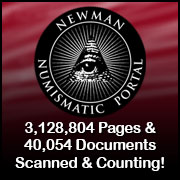
About UsThe Numismatic Bibliomania Society is a non-profit association devoted to the study and enjoyment of numismatic literature. For more information please see our web site at coinbooks.org SubscriptionsThose wishing to become new E-Sylum subscribers (or wishing to Unsubscribe) can go to the following web page link MembershipThere is a membership application available on the web site Membership Application To join, print the application and return it with your check to the address printed on the application. Print/Digital membership is $40 to addresses in the U.S., and $60 elsewhere. A digital-only membership is available for $25. For those without web access, write to: Charles Heck, Treasurer AsylumFor Asylum mailing address changes and other membership questions, contact Chuck at this email address: treasurer@coinbooks.org SubmissionsTo submit items for publication in The E-Sylum, write to the Editor at this address: whomren@gmail.com
BUY THE BOOK BEFORE THE COIN |
- WAYNE'S WORDS: THE E-SYLUM JUNE 17, 2020
- KOLBE & FANNING SALE 156 RESULTS
- ROSENBLUM'S NUMISMATIC LITERATURE MINILIST
- NEW BOOK: NUMISMATIC HISTORY OF QUMM
- NEW BOOK: SAVING THE OREGON TRAIL
- NEW BOOK: SWISS SHOOTING THALERS AND MEDALS, 3RD
- BANKNOTE BOOK FRENCH INDO-CHINA CHAPTER
- NEWMAN PORTAL: MORE ON THE GOLDEN BISCUIT
- VIDEO: CHESTER KRAUSE INTERVIEWED
- ANS MONEY TALKS: WHAT'S NEW AT NEWMAN PORTAL?
- NEWMAN PORTAL ANNOUNCES FIRST NNP SYMPOSIUM
- CORONAVIRUS UPDATES: JUNE 14, 2020
- NOTES FROM E-SYLUM READERS: JUNE 14, 2020
- TO COUNTERFEIT 'TIS DEATH
- MORE ON THE QUINT MINT
- MORE ON WHITMAN CHECKLISTS
- MORE ON THE C. E. HORNS COUNTERSTAMP
- HINDSIGHT ON THE COREY'S OINTMENT COUNTERSTAMP
- SO-CALLED DOLLAR LUCITE HOLDERS OFFERED
- VOCABULARY TERM: MEDALLIC ART
- CHARLES E. LEAL (1870-1894)
- NATIONAL EMERGENCY LIBRARY CLOSES
- INTERNATIONAL REFORMATION NUMISMATIC DAY
- HOLABIRD SUMMER 2020 SALES
- NUMISMATIC NUGGETS: JUNE 14, 2020
- GODS AND GODDESSES ON COINS
- COINS OF MACEDON BEFORE ALEXANDER
- ROMAN IMPERIAL COIN LETTERING
- 1713 PHILIP V GOLD COB 4 ESCUDOS
- KING GEORGE'S RECOVERY
- LEGISLATION TARGETS PURPLE HEART MEDAL SALES
- BEAUX-ARTS INSTITUTE OF DESIGN MEDAL
- RON GUTH ON COIN ORIENTATION
- 1794 FRANKLIN PRESS TOKEN CONSERVATION
- TENINO'S 2020 WOODEN MONEY
- BANKNOTE MAKER DE LA RUE SAYS DEMAND STRONG
- FORREST FENN REPORTS TREASURE FOUND
- NEW YORK TIMES PROFILES ARTIST JOHNNY SWING
- LOOSE CHANGE: JUNE 14, 2020
- FEATURED WEB SITE: GELDSCHEINE-ONLINE
Click here to access the complete archive
To comment or submit articles, reply to whomren@gmail.com
Content presented in The E-Sylum is not necessarily researched or independently fact-checked, and views expressed do not necessarily represent those of the Numismatic Bibliomania Society.
WAYNE'S WORDS: THE E-SYLUM JUNE 17, 2020
 This week we open with results of the recent Kolbe & Fanning literature sale, a numismatic literature pricelist, four new books, and several updates from the Newman Numismatic Portal.
This week we open with results of the recent Kolbe & Fanning literature sale, a numismatic literature pricelist, four new books, and several updates from the Newman Numismatic Portal.
Other topics this week include the Oregon Trail Half Dollar, the Quint Mint, counterstamps, medallic art, The American Numismatist, reformation numismatic day, auction previews, gods and goddesses on coins, coin lettering, Purple Heart medal legislation, the Beaux-Arts Institute of Design, and Johnny Swing's coin furniture.
To learn more about the Manchester Numismatic Society, the coinage of Qumm, banknotes of French Indo-China, artificial toning, Corey's Ointment, the Ben Fauver collection, the 1839 Silly Head cent, 1965-D coinage, and why people in Singapore collect Swiss shooting thalers, read on. Have a great week, everyone!
Wayne Homren
Editor, The E-Sylum
KOLBE & FANNING SALE 156 RESULTS
The latest Kolbe & Fanning numismatic literature sale was a big success. Here's a summary of the results. -Editor
KOLBE & FANNING AUCTION A HUGE SUCCESS
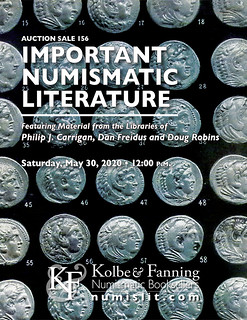 Kolbe & Fanning Numismatic Booksellers held our Sale 156 on Saturday, May 30, 2020. As we went to press in the midst of the Covid pandemic, we were a little uncertain about what to expect in terms of participation and prices. As it turns out, the sale was very successful, with nearly 200 registered bidders vying for 419 lots of books on ancient, world and U.S. numismatics, including material from the libraries of Phil Carrigan, Dan Freidus, and Doug Robins. Prices were strong, with the sale bringing 125% of its total pre-sale estimate.
Kolbe & Fanning Numismatic Booksellers held our Sale 156 on Saturday, May 30, 2020. As we went to press in the midst of the Covid pandemic, we were a little uncertain about what to expect in terms of participation and prices. As it turns out, the sale was very successful, with nearly 200 registered bidders vying for 419 lots of books on ancient, world and U.S. numismatics, including material from the libraries of Phil Carrigan, Dan Freidus, and Doug Robins. Prices were strong, with the sale bringing 125% of its total pre-sale estimate.
Some highlights of the sale include:
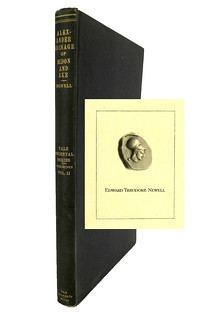
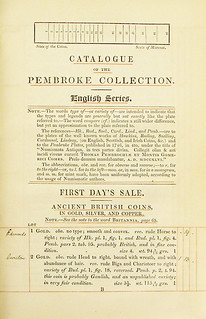
Lots 43 and 64
Lot 43: Edward T. Newell's own copy of his 1916 The Dated Alexander Coinage of Sidon and Ake, interleaved and extensively annotated, brought $2750 hammer against an estimate of $1200
Lot 64: a priced and named copy of the scarce 1848 sale of the extensive collection formed by Thomas Herbert, 8th Earl of Pembroke, realized an extraordinary $2000 hammer on a $350 estimate
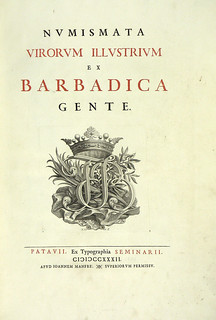
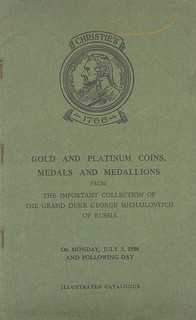
Lots 75 and 88
Lot 75: the majestic 1732 Numismata Virorum Illustrium ex Barbadica Gente, bound with the rare 1760 supplement with five additional plates, sold for $3000 on a $2000 estimate
Lot 88: a copy of the highly desirable 1950 Christie's sale of material from the collection of Russian coins and medals formed by Grand Duke Georgii Mikhailovich, estimated at $200, brought $1400 in spirited bidding
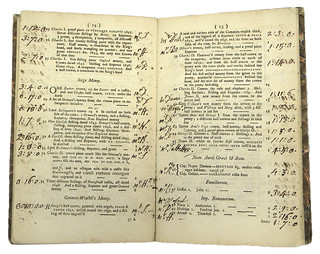
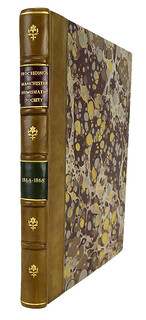
Lots 124 and 244
Lot 124: Eric P. Newman's copy of the rare 1756 sale of the Martin Folkes collection, priced and named, realized an exceptional $5000 hammer on a $750 estimate
Lot 244: Dr. Charles Clay's very rare 1864–1868 Manchester Numismatic Society serial, with the earliest photographic plates to appear in a numismatic journal (which depict American colonial coins in addition to other issues), saw very heavy bidding and closed at $4500 against a pre-sale estimate of $1000
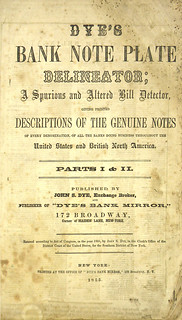
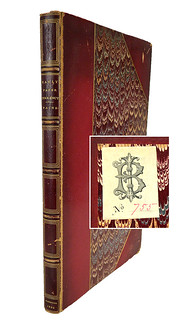
Lots 262 and 339
Lot 262: the extremely rare first printing of Dye's 1855 Bank Note Plate Delineator, designated on the title page as Parts I & II, and the only copy known to us in private hands, sold for $4250 on a $1500 estimate
Lot 339: Charles Bushnell's extra-illustrated copy of Nathaniel Paine's rare 1866 Remarks on the Early Paper Currency of Massachusetts, another pioneering use of photography in a numismatic work, brought $3250 on a 2500 estimate
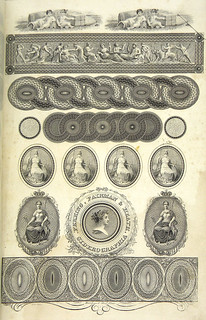
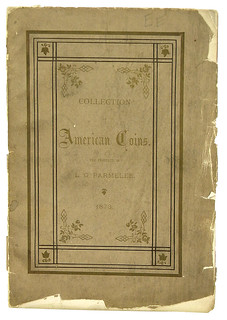
Lots 343 and 381
Lot 343: a very rare 1821 Jacob Perkins publication on the Prevention of the Forgery of Bank Notes, originally presented to a member of the Perkins family and previously thought to be unique, was the star of the sale, selling for a final bid of $19,000 on a $5000 estimate
Lot 381: William Strobridge's rare plated catalogue of the Seavey collection, from the Eric P. Newman Library and estimated at $2000, sold for $3250.
The full prices realized list may be downloaded at: https://www.numislit.com/pdfs/156PRL.pdf. Stated prices do not include the 20% buyer's premium.
We thank all of you who participated in our sale and invite you to browse our online retail inventory at numislit.com. If you would like to receive our promotional emails, you may sign up through numislit.com or drop us an email at df@numislit.com. We hope to be able to announce the date for Sale 157 in the near future.
To read the earlier E-Sylum articles, see:
KOLBE & FANNING SALE 156 ANNOUNCED
(https://www.coinbooks.org/v23/esylum_v23n19a02.html)
MORE KOLBE & FANNING SALE 156 HIGHLIGHTS
(https://www.coinbooks.org/v23/esylum_v23n20a03.html)
DAVE'S PICKS: KOLBE & FANNING SALE 156 HIGHLIGHTS
(https://www.coinbooks.org/v23/esylum_v23n21a02.html)
ROSENBLUM'S NUMISMATIC LITERATURE MINILIST
I really messed up last week's item on Bill Rosenblum's literature price list, grabbing a completely wrong image and URL. So let's start over.
Bill Rosenblum of Littleton, Colorado has published a price list of numismatic literature. -Editor
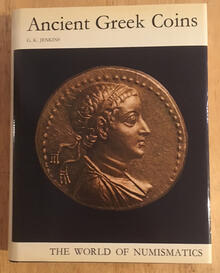
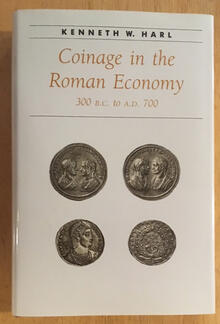
Rita has been bugging me since we moved almost 6 years ago to reduce the size of our library and to sell some of the books that are packed in cartons throughout our office and house. With this list we are attempting to do so. We hope to have a book list at least once a month.
Shipping is extra on all books. Please figure $5 for the first book and $3 for each additional book. Books will be sent Media Mail unless Priority Mail (more expensive) is requested. Shipping rates are for US orders only. Shipping books to other countries has become very expensive and in many cases the shipping overseas will be more expensive than the book itself.
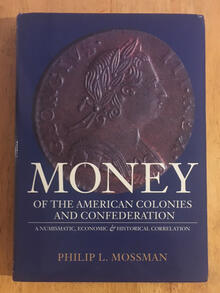
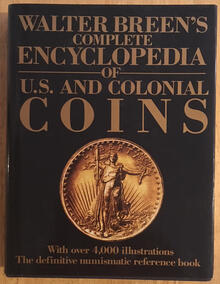
When books are not new we have tried to describe the condition to the best of our ability. We will at times use numismatic grading terms, not book grading terms, to describe the condition of the books. No photos for this list although if you need a scan of the cover we will try to provide it.
To read the complete list, see:
http://rosenblumcoins.com/
and click "Current Sale" then Books/Literature, or
Books/Literature
(http://rosenblumcoins.com/sales#books-literature)
NEW BOOK: NUMISMATIC HISTORY OF QUMM
Roland Dauwe has published a new book on the coinage of the Holy City of Qumm. -Editor
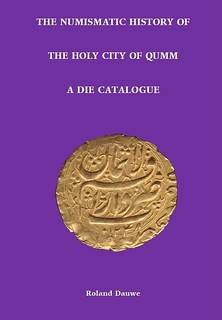 The Numismatic History of the Holy City of Qumm. A Die Catalogue.
The Numismatic History of the Holy City of Qumm. A Die Catalogue.
by Roland DAUWE
Several years ago Roland Dauwe found it very strange that so few coins were recorded to be struck in Qumm, considering the importance of the town. Not only was Qumm, and still is, a sacred city for the Shi‘ite Muslims, but its location on the main road from Rayy (now part of Tehran) to Isfahan was of great strategic importance.
During his research it soon became clear that most Qumm coins, except for some Timurid issues, are all rare to extremely rare. In the meantime, he found that for most issues a very small number of dies were used, strengthening his conviction that a die corpus would be of great use for identifying the coins with partial dates or even those with the mint missing. Buying Qumm coins whenever possible, he was able to build up a collection of more than 300 pieces. With that as a base and after visiting several coin cabinets and contacting other private collectors, it was possible to complete little by little his idea of the minting activity of Qumm.
The coinage is divided into four main groups. The first group comprises the early traditional coinage, running from the Arab-Sasanian issues to the Great Seljuqs; the second group comprises the Mongol and post-Mongol coins, from the Ilkhans to the Aq Qoyunlu; the third group consists of the issues of the recent Iranian dynasties, from the Safavids to the Qajars; and finally the fourth group comprises the local civic coppers.
Hardcover, 192 pages, format 210 x 297 mm. Price: € 35.00 excl. S/H.
Members of the Numismatic Society of Diest & the Oriental Numismatic Society can buy this book at € 19, excl. S/H.
E-mail: patrick.pasmans@hotmail.com
More information on : www.muntmeester.be
NEW BOOK: SAVING THE OREGON TRAIL
Gary Greenbaum passed along information about a new book relating to a classic U.S. commemorative coin - the Oregon Trail Memorial half dollar. -Editor
Gary writes:
"This is Dennis M. Larsen's final volume in his biographical series on pioneer Ezra Meeker (1830-1928), “Saving the Oregon Trail”, covering his final years and the origin of the Oregon Trail Memorial half dollar (he does me the courtesy of using my two published articles in The Numismatist on the subject as sources). He picks up on my theme that that long-lived half dollar was not about greed or fraud, but at worst incompetence and over enthusiasm, and criticizes some of what has been written on the subject by people like David Bowers."
Here's a description from the publisher's site with some additional photos from Gary. -Editor
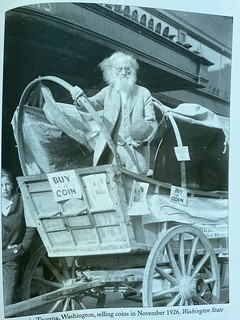
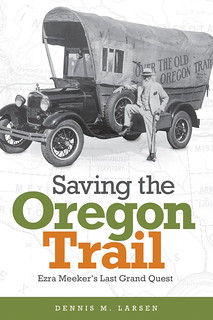
Ezra Meeker lived ninety-eight highly productive years. At times endearing and captivating, he could also be exasperating and irrational. Once he committed to a cause, he was an unabashed promoter. Meeker devoted his final three decades to commemorating the Oregon Trail. A part of his story no one has previously told, this volume begins in 1901 and completes an epic biography.
One of Washington Territory's earliest pioneers, Meeker first came west on the overland trail in 1852. He became a Puyallup community builder, agricultural tycoon, and world traveler before hop lice and the Panic of 1893 devoured his fortune. He dallied in mining and joined the Klondike gold rush, spending four years as a Yukon store proprietor.
At age 75 he trekked east over the Oregon Trail with oxen and a covered wagon, setting markers along the way, and became a national celebrity. He visited New York, Washington, D.C., and the White House, and managed to convince regular citizens, the rich and famous, governors, legislators, and even three U.S. Presidents to support his trail preservation schemes.
Never one to shy away from adventure, his other exploits included publishing books, lecture tours, additional Oregon Trail expeditions (one in a bi-plane), attending the Alaska Yukon Pacific Exposition, experimenting with motion pictures, founding societies, cruising in what may have been the first motorized RV, performing in a Wild West show, and roaming the country selling commemorative coins. In the end, Meeker's extraordinary efforts were crucial to saving the trail.
“Ezra Meeker was inspirational, charismatic, and beloved but also arrogant, aggravating, cantankerous, and obnoxious. Dennis Larsen's biography sings his praises, exposes his flaws, and shows why without Meeker, America might have forgotten the Oregon Trail's epic story.”—Will Bagley, Independent Historian
Illustrations / maps / notes / bibliography / index / 278 pages (2020)
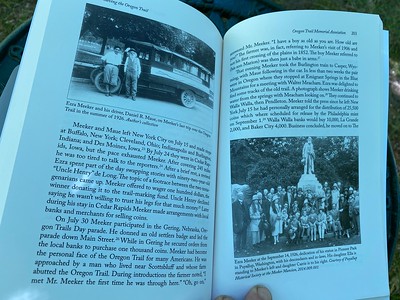
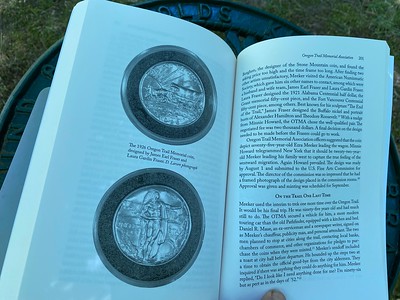
For more information, or to order, see:
SAVING THE OREGON TRAIL
Ezra Meeker's Last Grand Quest
(https://wsupress.wsu.edu/product/saving-the-oregon-trail/)
Saving the Oregon Trail: Ezra Meeker's Last Grand Quest
(https://www.amazon.com/dp/0874223741/ref=sr_1_10)
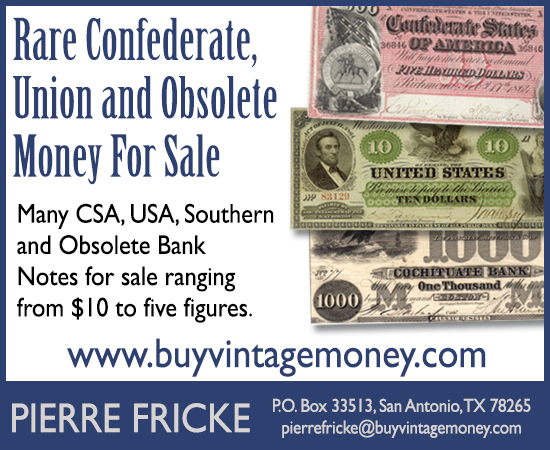
NEW BOOK: SWISS SHOOTING THALERS AND MEDALS, 3RD
The June 11, 2020 issue of CoinsWeekly has an article by editor Ursula Kampmann reviewing a new edition of a book on Swiss shooting thalers and medals (linked below). Here's some information from the publisher's web site, but be sure to read the article for the full background on a wonderful collaboration. -Editor
Keh Wee Kwang | Jürg Richter | Marcel Häberling
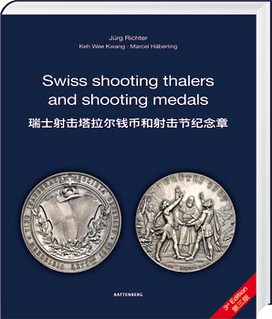 Swiss shooting thalers and shooting medals
Swiss shooting thalers and shooting medals
瑞士 射击 塔拉尔 钱币 和 射击 节 纪念章
Published by Battenberg Verlag
ISBN: 978-3-86646-193-2
Edition: 3rd edition 2020
Illustrations: colored throughout
Hardcover: 632 pages
Format: 23.5 x 28 cm
This book deals with the history as well as the historical background of the marksmen and marksmen medals of Switzerland. Over 2500 thalers and medals from the beginning in the early 17th century to 1960 were listed in detail and the majority were shown. This book thus becomes an indispensable reference work when it comes to determining and evaluating marksmen and marksman medals in Switzerland. Now in the 3rd edition as a German-Chinese version!
According to the CoinsWeekly article the book is actually an English-Chinese version, the result of an international collaboration among collectors, dealers and the publisher. The article answers the question, "Why do people collect shooting thalers in Singapore?" The chain of events leading to the book's publication is quite interesting and encouraging for the future of numismatics.
Swiss dealer Marcel Häberling's first-time visit to the Singapore Coin Fair in 2011 inspired Singapore collector Keh Wee Kwang who later became a dealer in the pieces. The two then collaborated with Jürg Richter on the new edition. While the first two editions were primarily catalogs, this new edition adds descriptions of all the key people, events, symbols, myths and legends that non-Europeans would not be familiar with, thus making the book quite useful for any reader.
Dealers, collectors and publishers all have a part to play in promoting numismatics in general, and this is a great case study in how a specific series can become popular far away from its traditional collecting base. -Editor
For more information, or to order, see:
Swiss shooting thalers and shooting medals
(https://www.battenberg-gietl.de/sammeln/buch/swiss-shooting-thalers-and-shooting-medals)
To read the completeCoinsWeekly article, see:
Swiss Shooting Thalers the Chinese Edition
(https://coinsweekly.com/swiss-shooting-thalers-the-chinese-edition/)
To read the earlier E-Sylum article, see:
NEW BOOK: SWISS SHOOTING THALERS AND MEDALS, 2ND
(https://www.coinbooks.org/v21/esylum_v21n21a06.html)
BANKNOTE BOOK FRENCH INDO-CHINA CHAPTER
Owen Linzmayer publishes The Banknote Book, a useful, constantly updated electronic reference. On June 12, 2020 he announced via email the availability of the French Indo-China chapter. It's available for $9.99. -Editor
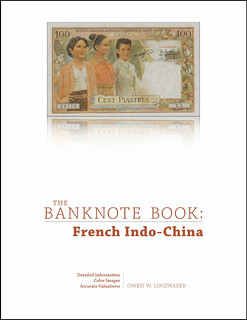 French Indo-China (East and Southeast Asia)
French Indo-China (East and Southeast Asia)
This 48-page catalog covers notes issued by the Banque de l'Indo-Chine (Bank of Indo-China) from 1888 to 1951, Gouvernement Général de l'Indochine (Government General of Indo-China) from 1940 to 1944, Greater Japan Imperial Government from 1940 to 1944, and Institut d'Émission des États du Cambodge du Laos et du Viet-Nam Viện Phát Hành (Issuing Institute of the States of Cambodia, Laos, and Viet-Nam) from 1953 to 1954.
Currently 289 chapters of The Banknote Book have been published as individual high-resolution PDF files. This represents a total of 6,700 pages covering 60,950 types and varieties.
For more information on The Banknote Book, see:
http://www.banknotenews.com/banknote_book/banknote_book.php
NEWMAN PORTAL: MORE ON THE GOLDEN BISCUIT
Newman Numismatic Portal Project Coordinator Len Augsburger provided these comments on coin nicknames. Thanks! -Editor
More on the Golden Biscuit
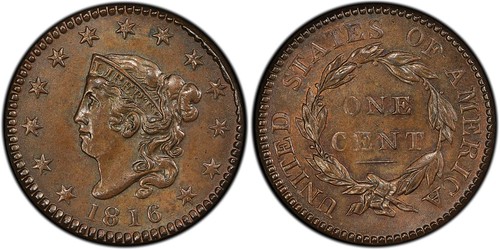
In the 6/7/2020 E-Sylum Ron Guth mentioned the “golden biscuit,” referring to an 1816 N-1 large cent presented by Doug Smith in an 1976 EAC whist match with Ted Naftzger. Newman Portal results for “golden biscuit” provide additional context on the use of this term. The earliest mention found is the February 1976 Stack's sale in which the cataloguer (probably Smith) describes an 1827 N-1 cent, in part: “the obverse brings to mind a golden biscuit fresh from the oven.” The usage of the term evolves to silver coins, such as in Goldberg's Kardatzke I (February 2002, lot 1165) where an 1894-S 50c is cataloged as “a golden biscuit from the mint's oven. Lovely and delicious.” Still, “golden biscuit” is used primarily with copper and more specifically with the Smith 1816 N-1, which reappears in in the Stack's Halpern sale (March 1988, lot 286).
Good coins need good names, such as the “ice cream” specimen of the 1894-S dime, or the “Martha Washington” 1792 half disme. This is a longstanding tradition within American numismatics, well-established with the publication of the Dr. Maris 1869 work on 1794 cent varieties. Maris proposed descriptive terms for various 1794 large cent varieties, such as the “scarred head,” “pyramidal head,” “patagonian,” etc. The sheer quantity of coin varieties demands the use of numbers at some point, but the use of descriptive terms for more memorable pieces lends color to what might otherwise be tedious technical studies.
Link to NNP search results for “golden biscuit”:
https://nnp.wustl.edu/library/searchwithterms?searchterm=golden%20biscuit
Link to Edward Maris's Varieties of Copper Issues of the United States Mint in the Year 1794:
https://nnp.wustl.edu/library/book/523977
To read the earlier E-Sylum article, see:
LOOSE CHANGE: JUNE 7, 2020 : The Golden Biscuit
(https://www.coinbooks.org/v23/esylum_v23n23a41.html)
VIDEO: CHESTER KRAUSE INTERVIEWED
These are selections from the David Lisot Video Library that feature news and personalities from the world of coin collecting. David has been attending coin conventions since 1972 and began videotaping in 1985. The Newman Numismatic Portal now lists all David's videos on their website at:
https://nnp.wustl.edu/library/multimediadetail/522852
Here's an interview with Krause Publications founder Chet Krause. -Editor
PNG Living History: Chester Krause, 8/15/1988
David Lisot, Interviewer.
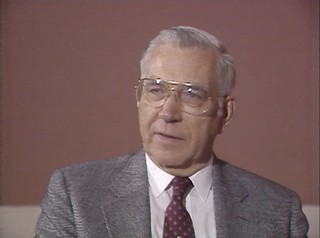 Chester Krause created of the largest publishing companies devoted to coins and collecting. Chet shares how got started in coin collecting. He shares how he started Numismatic News and Krause Publications in 1952 and other stories about the coin hobby.
Chester Krause created of the largest publishing companies devoted to coins and collecting. Chet shares how got started in coin collecting. He shares how he started Numismatic News and Krause Publications in 1952 and other stories about the coin hobby.
An excerpt of the video is available for viewing on the Coin Television YouTube Channel at:
https://youtu.be/J3fMIve3mUM
ANS MONEY TALKS: WHAT'S NEW AT NEWMAN PORTAL?
As a reminder, the American Numismatic Society will be holding a Money Talks conference about the latest developments at the Newman Numismatic Portal. It's for members only, but a great reason to join. -Editor
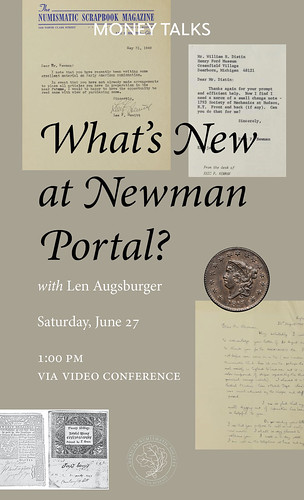 The Newman Numismatic Portal is an online numismatic library that holds over 40,000 items. This presentation will provide an overview of the collection and in particular discuss activities at the ANS library.
The Newman Numismatic Portal is an online numismatic library that holds over 40,000 items. This presentation will provide an overview of the collection and in particular discuss activities at the ANS library.
The Newman Portal is administered by Washington University in St. Louis, with funding from the Eric P. Newman Numismatic Education Society, and maintains scanning operations at Washington University, ANS, and the National Archives & Records Administration. Len Augsburger, NNP Project Coordinator and ANS Fellow, will present.
This Money Talks will be held live via video conference. The session is open to ANS members only. RSVP to Emma Pratte at membership@numismatics.org to get the link.
For more information on ANS Money Talks, see:
http://numismatics.org/moneytalks/
For information on ANS Membership, see:
http://numismatics.org/membership/
To visit the Newman Numismatic Portal, see:
https://nnp.wustl.edu/

NEWMAN PORTAL ANNOUNCES FIRST NNP SYMPOSIUM
The Newman Numismatic Portal itself will be sponsoring a symposium at the end of August. Here's the initial announcement. -Editor
FIRST NNP SYMPOSIUM
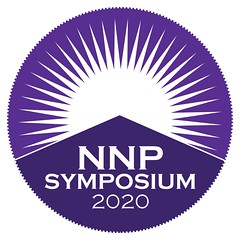 The Internet has fundamentally transformed numismatics in the last generation with the development of online trading platforms, information repositories, and social media sites that facilitate communication among coin collectors, dealers, and researchers. The Newman Numismatic Portal
(
http://newmanportal.org/) was founded in 2014 with the objective of making available a comprehensive, online numismatic library on a free and forever basis. Today, Newman Portal is widely recognized as the go-to resource for research on American numismatics, containing over 40,000 documents and delivering access to critical archival resources such as the U.S. Mint correspondence held by the National Archives & Records Administration.
The Internet has fundamentally transformed numismatics in the last generation with the development of online trading platforms, information repositories, and social media sites that facilitate communication among coin collectors, dealers, and researchers. The Newman Numismatic Portal
(
http://newmanportal.org/) was founded in 2014 with the objective of making available a comprehensive, online numismatic library on a free and forever basis. Today, Newman Portal is widely recognized as the go-to resource for research on American numismatics, containing over 40,000 documents and delivering access to critical archival resources such as the U.S. Mint correspondence held by the National Archives & Records Administration.
Newman Portal today announces the launch of NNP Symposium ( http://nnpsymposium.org/), an online gathering of the numismatic community. The first event will occur August 28-29, 2020. These twice-annual, free symposia will bring together a wide array of numismatic content including club meetings, individual presentations, and panel discussions. While spurred by the COVID-19 epidemic, the NNP Symposium concept addresses other issues related to attendance at existing trade events. Participants may not always be able to travel to conventions or may wish to attend only limited portions of a given event. The NNP Symposium reduces these barriers to entry and makes attendance as simple as pulling up a screen on a laptop, mobile, or smart TV.
Today's technologies allow for the virtual gathering of existing numismatic communities and pave the way for the formation of new interest groups. Many organizations are beginning to take advantage of this capability and are seeing strong attendance at club meetings, including participants from distant locales. NNP Symposium seeks to build on this momentum and to create synergy around a single, focused two-day event by freely providing the logistical services and support demanded by ever-evolving technologies. NNP Symposium is confident the numismatic community can be strengthened by creating connections within a wider, online audience whose numismatic affinity is not always apparent at physical conventions.
The NNP Symposium invites numismatic organizations and individual presenters to register for a Symposium meeting slot. Inquires may be submitted at http://nnpsymposium.org/for-presenters. Dealers are welcome to participate and might use this time to introduce their business or present selected inventory highlights. The NNP Symposium staff will ensure smooth delivery of all content by providing Zoom training to attendees and presenters prior to the event. NNP Symposium will additionally furnish live facilitators to manage technical issues during each meeting.
Committed speakers as of press time include:
Greg Rohan: President of Heritage Auctions, Rohan will speak on the state of the current rare coin market and the effects of COVID-19 on the auction business.
John Brush: President of David Lawrence Rare Coins, Brush will discuss the unparalleled Dell Loy Hansen collection, the Eliasberg quest, and the formation of this spectacular American coin cabinet.
John Dannreuther: A fifty-year veteran in the numismatic industry and one of the most highly respected researchers, Dannreuther will speak on the enigmatic 1841 quarter eagle, an enduring mystery of American numismatics.
Wayne Homren: Editor of the widely-read weekly E-Sylum, Homren will present on the performance artist J.S.G. Boggs, who created intricate reproductions of U.S. currency in exchange for goods and services.
Mike Nottlemann & Matt Dinger: Hosts of the Coin Show podcast and two of the most engaging personalities currently on the numismatic scene, Dinger and Nottleman will livestream a Coin Show episode during the NNP Symposium.
Chris McDowell: Editor of the Journal of Early American Numismatics, McDowell will speak on his efforts to revise the Charles W. Betts work on pre-revolutionary medals related to America.
Joel Orosz & Len Augsburger: The highly-awarded pair of numismatic authors Orosz and Augsburger will present on the rare first printing of Eric P. Newman and Kenneth E. Bressett's The Fantastic 1804 Dollar.
NNP Symposium attendees may register at http://nnpsymposium.org/register and will receive periodic updates including overall schedule and meeting links. Symposium registration and meeting planning services are free, consistent with the Newman philosophy of freely providing resources for the greater good of the wider numismatic community. As with the Newman Portal, costs of creating and hosting this new concept will be completely underwritten by the Eric P. Newman Numismatic Education Society (https://epnnes.org/), in furtherance of its numismatic-focused charitable mission.
CORONAVIRUS UPDATES: JUNE 14, 2020
Here's the latest compilation of coronavirus updates from readers, organizations and companies. -Editor
David Lange (June 10, 2020)
In his Summer 2020 Coin Board News author David Lange writes:
 "DISPATCH FROM THE BUNKER In the Spring issue I speculated that we
soon might be under quarantine, and to varying degrees this has come to pass. Most coin shows have been cancelled through July, with the August ANA
Convention uncertain as of this writing. It's one of the most highly anticipated events on my calendar, along with the ANA's Summer Seminar, already lost to the pandemic.
"DISPATCH FROM THE BUNKER In the Spring issue I speculated that we
soon might be under quarantine, and to varying degrees this has come to pass. Most coin shows have been cancelled through July, with the August ANA
Convention uncertain as of this writing. It's one of the most highly anticipated events on my calendar, along with the ANA's Summer Seminar, already lost to the pandemic.
While the virus situation is ongoing my work has alternated between home and office, but any additional travel is limited to once-weekly jaunts to the supermarket, during the very early “seniors only” hour, and to the post office to pick up mail, mostly when only the box lobby is open.
Despite these fears and restrictions our hobbies somehow go on, and I've acquired a few nice boards in recent months, including some upgrades to my own collection. I'm foregoing the usual list of boards for sale this time, and the newsletter will be a short one. My best wishes to all for good health and safety."
See this issue's NOTES FROM E-SYLUM READERS for Dave's update on his upcoming book on Whitman coin folders. -Editor
IPMS 2020 Virtual Convention (June 12, 2020)
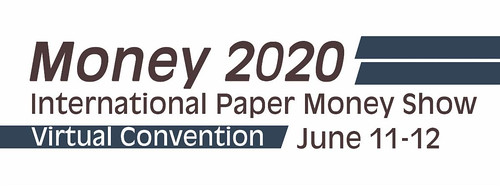
The program was announced too late for our last issue, but the International Paper Money Show staged a virtual convention this week with nine speaker presentations held via Zoom meetings. Some of the talks may be made available online and we'll publish details once announced. As announced in another article elsewhere in this issue, the Newman Numismatic Portal will sponsor an online seminar in August.
I think we're about to experience a tsunami of virtual numismatic speaking. Organizations, speakers and collectors alike have learned how easy it is to hold these conferences, and I understand many more are being planned in the US and around the world. So many in fact, that it may become impossible to attend all that one might like to because of scheduling conflicts or the sheer lack of time.
Coin publications were once the clearinghouse for announcing show dates and they still are, but show calendars have moved online. As more and more virtual conventions and educational talks move online, there will be a need for new or expanded calendars to keep track of these virtual events. We'll certainly help publicize any that we become aware of, but the plethora of upcoming events could become a problem. -Editor
Stack's Bowers ANA Auction Plans (June 12, 2020)
From the announcement:
 "In the event that the ANA World's Fair of Money in Pittsburgh, Pennsylvania is canceled, Stack's Bowers Galleries plans to move our auction to Las Vegas, Nevada to be held alongside the previously announced “substitute” PCGS Members Only Show.
"In the event that the ANA World's Fair of Money in Pittsburgh, Pennsylvania is canceled, Stack's Bowers Galleries plans to move our auction to Las Vegas, Nevada to be held alongside the previously announced “substitute” PCGS Members Only Show.
"Our tentative plans for the auction and lot viewing are as follows:
"Stack's Bowers Galleries
California Headquarters Lot Viewing
July 20 through July 24
"Dallas, Texas Lot Viewing
July 31 through August 2
"Las Vegas, Nevada
Auction and Lot Viewing
August 5 through August 7
"Please save these dates and mark your calendars accordingly. More details will follow if the World's Fair of Money is formally canceled. Please note that we do not have any information outside the public domain regarding the status of the show.
"Stack's Bowers Galleries is still accepting consignments for our Official Auction of the ANA World's Fair of Money and generous cash advances are available. For more information please inquire by phone (800-458-4646) or by email at consign@stacksbowers.com."
On Mask-Wearing
Bill Eckberg writes:
"Remember when showing up at a bank or a coin show wearing a mask was a bad thing?"
To read the earlier E-Sylum article, see:
CORONAVIRUS UPDATES: JUNE 7, 2020
(https://www.coinbooks.org/v23/esylum_v23n23a14.html)
NOTES FROM E-SYLUM READERS: JUNE 14, 2020
Correction: Walter Breen Video Link
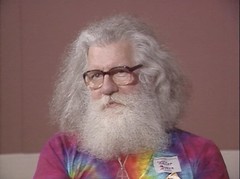 Last week's article about the David Lisot video interview with author Walter Breen included an incorrect link. Thanks to reader
Bob Bair for the heads' up. We've corrected our archive. To watch the video, click here:
Last week's article about the David Lisot video interview with author Walter Breen included an incorrect link. Thanks to reader
Bob Bair for the heads' up. We've corrected our archive. To watch the video, click here:
https://youtu.be/UMqJDo2WazY
-Editor
To read the earlier E-Sylum article, see:
VIDEO: WALTER BREEN INTERVIEWED
(https://www.coinbooks.org/v23/esylum_v23n23a10.html)
Numismatic Literature Buyers in the 1864 John Allan Sale
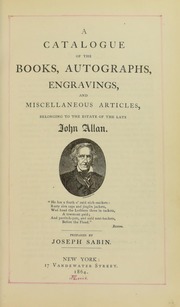 Dave Hirt writes:
Dave Hirt writes:
"I would like to thank the Newman Portal for the post on my catalog of the John Allan Sale. Of the 3315 lots of books, I counted 80+ with references to numismatics. W.S. Appleton was the number 1 buyer of these books. Edward Cogan was number 2. Many of the non-numismatic books were so amazing, with hand colored plates, special editions and bindings that no book lover could go through that list quickly. "
To read the earlier E-Sylum article, see:
THE 1864 JOHN ALLAN SALE
(https://www.coinbooks.org/v23/esylum_v23n23a09.html)
Query: United States Mint Silver Dollar Collection
D Bruce writes:
"I purchased some coins and a set of 1922 thru 1926 peace dollars were among them. But they're in a case marked "United States Mint". I can't find any information about where they were sold from. I asked some dealers and no one remembers ever seeing this set. I don't know if the mint souvenir shop sold them. Maybe one of the readers knows or has some ideas."

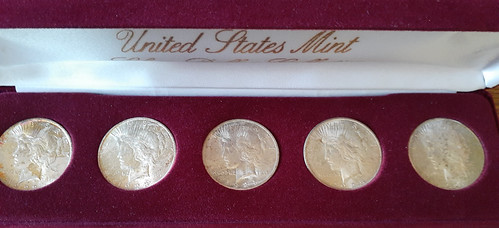
Without a U.S. Mint logo or other such text, this seems to me like an independent seller's product, perhaps from one of those mass-market publication ads offering 5 silver dollars for the price of 10. But I could be wrong. Is anyone aware of a U.S. Mint marketed product like this? -Editor
A Counterstamped Mexico 2 Real
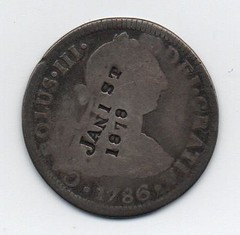
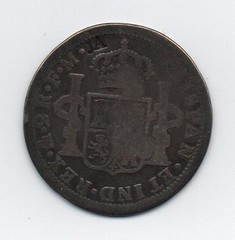
Howard A. Daniel III writes:
"I am going through my collections and finding pieces which I can donate or sell to assist me in downsizing. I found this 2 Reales 1786 FM KM-88.2a coin in my chopmarked coin album that likely circulated in the USA as a quarter. It has "Jan 1st 1878" date on the obverse and a small "JA" on the reverse. I have never determined what event is being recorded, but I am thinking there is someone out there who knows JA and his or her date. It is free to any museum collection, but if you want it for your personal collection, make me an offer at HADANIEL3@MSN.COM. First come museum gets it for free or highest offer gets it."
Can anyone help with the attribution? -Editor
Natural and Artificially-Induced Toning
Frederick A. Liberatore writes:
"The new book "Dancing on Rainbows" does show some very beautifully toned coins. However, I have watched an exposer of coin doctors air tone coins with the vapors from chemical solutions in minutes. They were beautiful, really lovely. In fact, I was reminded of the images I had seen of toned coins sold in auctions for considerable premiums. The demonstrater performed this magic at the American Numismatic Summer Sessions in June-July 2018 in Colorado Springs.
My advice to collectors is to NEVER pay a premium for toning. If anyone has seen a way to distinguish natural from artificially induced toning, I hope they will share it with readers of The E-Sylum."
To read the earlier E-Sylum articles, see:
NEW BOOK: DANCING ON RAINBOWS
(https://www.coinbooks.org/v23/esylum_v23n22a04.html)
NOTES FROM E-SYLUM READERS: JUNE 7, 2020 : More on Dancing on Rainbows
(https://www.coinbooks.org/v23/esylum_v23n23a18.html)
On Custom Slab Labels
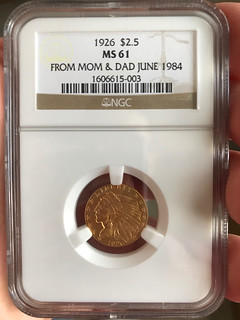 Regarding custom slab labels,
Erik Goldstein writes:
Regarding custom slab labels,
Erik Goldstein writes:
"When I graduated High School in 1984, my parents gave me a 1926 $2.50 Indian. I sent this cherished present – my first gold coin ever - to NGC to be slabbed a few years back. They gladly included the line “From Mom & Dad June 1984” on the line below the date/denomination."
So it is possible to ask the grading companies to customize annotations on slabs. They may not be able to accommodate everyone, but it can't hurt to ask. -Editor
To read the earlier E-Sylum article, see:
NOTES FROM E-SYLUM READERS: JUNE 7, 2020 : Custom Slab Labels
(https://www.coinbooks.org/v23/esylum_v23n23a18.html)
Upcoming Book: Whitman Folders and Albums
In his Summer 2020 Coin Board News author David Lange writes:
"BOOK UPDATE The third volume in my series of books relating the histories and product lines of coin album publishers is in the layout process, and that work is nearly completed. Expected for a late summer release, its title is Coin Collecting Albums: A Complete History and Catalog Volume Three, Whitman Publishing Company Folders and Albums 1940-1978. The book is about 350 pages and in full color throughout. I anticipate having it bound with a soft cover to keep down both weight and binding costs, but it will be a deluxe softcover with sewn signatures to prevent the falling out of pages so common to cheap, “perfect bound” books.
I'm delighted with the completed chapters from my book designer, and this entry should really fill an important gap in hobby history. In addition, Lange Numbers will now exist for each and every variety of Whitman folder and album, and this will make the collecting and cataloging of these items far more satisfying. The inventory of duplicate folders I amassed while preparing this book will soon be offered for sale, and the next list I send out may be for folders rather than boards. I'll hold off on doing that, however, until persons desiring to do so have been able to acquire the book."
I'm looking forward to this book, having grown up like so many of us pushing coins into Whitman folders. See last week's article (linked below) for a short excerpt on the related Whitman checklists. -Editor
To read the earlier E-Sylum article, see:
WAYNE'S NUMISMATIC DIARY: JUNE 7, 2020 : Whitman Coin Checklist
(https://www.coinbooks.org/v23/esylum_v23n23a28.html)
Canadian Coins Roll Hunting Playmat
David Pickup passed along this numismatic product. Thanks. It appears to be a soft placemat for sorting coins. -Editor
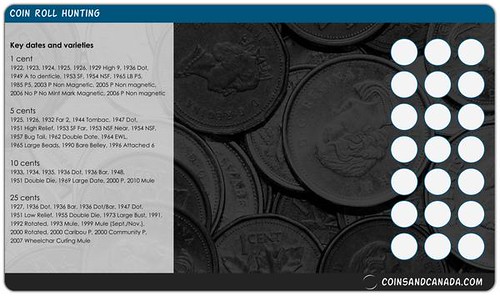
Standard Playmat is approximately 24" x 14".
Oversize Playmat is approximately 28" x 14".
Thickness: 1/16 an inch
Smooth cloth top with rubber bottom for traction
Vibrant Colors
Machine Washable
To read the complete product description, see:
CANADIAN COIN ROLL HUNTING PLAYMAT
(https://www.inkedgaming.com/collections/playmats/products/canadian-coin-roll-hunting-playmat)
The Open Directory Project
NBS webmaster Bruce Perdue writes:
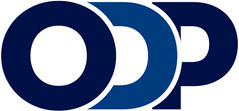 "Reading the article on the Weird Things People Collect, took me back to the Open Directory Project where we met. I edited the category where all of the things people collected but were not indexed anywhere else were listed. The "Airline Barf Bag" collection category is one of the ones that I remember well. It's too bad the ODP went away."
"Reading the article on the Weird Things People Collect, took me back to the Open Directory Project where we met. I edited the category where all of the things people collected but were not indexed anywhere else were listed. The "Airline Barf Bag" collection category is one of the ones that I remember well. It's too bad the ODP went away."
I remember ODP, but had forgotten that's how Bruce and I first met. I had been updating the numismatic web site portion of the ODP, an early crowdsourced tool for organizing content on the internet. Specifically, I think I was updating lists of numismatic literature sites.
The Open Directory never disappeared, it just faded from view as search engines made it obsolete for most purposes. The site has a spiffier interface now, but the content is stale and full of broken links, like a sad abandoned amusement park.
It's a shame though. Directories are useful despite the scalability and general utility of search engines. In numismatics today the Newman Numismatic Portal search bar is where many people start their research, but the content directory menus are also useful for navigating directly to something you already know you want, or for browsing topic areas. That can't be done with a search engine. One thing Google can never answer is a question like, "Do you have all the issues of Mehl's Numismatic Monthly?" -Editor
To visit the Open Directory Project, see:
Web Directory of High-quality Resources
(http://odp.org/)
Directory of Numismatics Resources
(http://odp.org/Shopping/Publications/Books/Antiques_and_Collecting/Numismatics)
To read the earlier E-Sylum article, see:
WEIRD THINGS PEOPLE COLLECT
(https://www.coinbooks.org/v23/esylum_v23n23a40.html)
Gender in Book Collecting
Len Augsburger passed along this announcement for the bibliophiles among us. Thanks. -Editor

Sex and Gender in Book Collecting
Thursday, June 18, 2020
3-4 p.m. CDT
Registration required
In the late nineteenth and early twentieth centuries, men dominated book collecting and women were often painted as enemies of books. University Libraries' Curator of Rare Books Cassie Brand will discuss gender roles and sex as it related to book collecting in this time period, including how men sexualized books and the use of human skin binding.
To register, see:
Bound in Tight Leather: Sex and Gender in Book Collecting
(https://wustl.zoom.us/webinar/register/WN_L9TKqjx0QI65L4cVNQy1QQ/)
Query: Brightening an Annealed Bronze or Brass Planchet
Dick Hanscom writes:
"When annealing a bronze or brass blank or planchet, it darkens or turns black. How does one brighten the surfaces before striking?"
Hollinbeck Auction Flips
Michael Merrill writes:
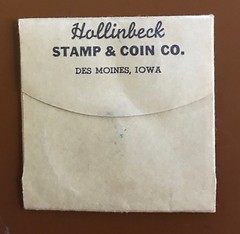 "It's clean-up time these days, and I found a box of old, old business cards, 1970's/1990's. Amongst them were these five Hollinbeck auction flips from yesteryear. I must have bought these coins in the 70's/80's, sold them, and totally forgotten about the flips. Interesting grade range from $10. Indian in Fine to
$20. Lib. described as Unc. or Proof. Wonder what the price difference in May 1951 would have been."
"It's clean-up time these days, and I found a box of old, old business cards, 1970's/1990's. Amongst them were these five Hollinbeck auction flips from yesteryear. I must have bought these coins in the 70's/80's, sold them, and totally forgotten about the flips. Interesting grade range from $10. Indian in Fine to
$20. Lib. described as Unc. or Proof. Wonder what the price difference in May 1951 would have been."
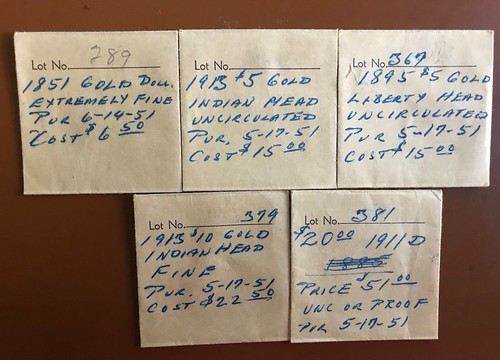
Thanks! Very interesting. That Time Machine sure would come in handy. -Editor
Michael adds:
"In 1951 I was 10, and that was the year my best friend was given a small box of US coins by a real estate agent who was a family friend, who found them in an abandoned house he was selling. This box contained perhaps 100+ US coins culled from circulation, nothing special or rare, as I remember. They included a 100+ year diverse cross-section of circulated type coins dating back to early coppers pre-1800 thru early 20th century. My friend graciously gave me a handful from the box, and Voila!, little did I know then that this was part of the inspiration behind my starting a long-time coin business many years later. Interesting how a simple gesture like this can steer one's life's work! My love of coins is far greater now than then, but as we all know, often passions get into your blood and never leave!
"Baltimore coin dealer Alfred Hutter, at 321 N. Charles St, in a small, corner, basement step-down location, was my go-to dealer. He later moved to Cumberland, MD. At a small Baltimore coin show, perhaps 10-15 years ago, I was rather surprised to see a sign above a dealer table with the surname “Hutter”. He was related."
To read an article on Art Kagin and the Hollinbeck Coin Company, see:
A.M. ''Art'' Kagin - In Memoriam
(https://www.pcgs.com/news/am-art-kagin-in-memoriam)
TO COUNTERFEIT 'TIS DEATH
Paul Schultz writes:
"Just an FYI on a historical footnote, not relevant to the issues of today, you mentioned "Even when the words "To counterfeit 'tis death" were printed on bills I don't think that sentence was ever carried out.-Editor"
In England in the 1600s and 1700s it was actually carried out. I do not have the references on hand, but I have read numerous descriptions of counterfeiters being hanged. Of course, they were caught with all of the equipment necessary and stacks of counterfeit money so there was no doubt of guilt. Many people did not approve, others regarded all hangings as an afternoon of amusement, but the practice was discredited before 1800 if I remember right. I can not say if anyone in the American colonies or the US was ever executed for counterfeiting, others may know better than I do. Laws here were a bit lenient compared to Europe, they burned witches at the stake over there, but in the colonial US we just hung them. One was my 10 Greats grandmother, Lydia Gilbert, hung as a witch in 1652 in Hartford CT."
I was speaking of the colonial American penalty, and it would only take one example to prove me wrong. But yes, the death penalty for counterfeiting was enforced in other times and places. Sorry to hear about your ancestor!
Here's one account of colonial counterfeiting justice. So much has been written on the topic I'm not sure where to start. But I'd be happy to be proven wrong if someone can cite an example of the death penalty for counterfeiting being carried out of U.S. soil. -Editor
Ichabod Miller eked out a living on his farm in West Stockbridge, Mass. On December 20, 1772, his pastoral life was turned upside down.
Miller was awoken to the commotion of an angry mob at his door. In a moment they had broken in the door and he faced the business end of a loaded musket. He was accused of counterfeiting. This crime could be heart stopping. If proven, the sentence was death.
Counterfeiting was fairly prevalent in the colonies at this time. It was relatively easy to do, it was extremely profitable, hard to discover, and even harder to prosecute.
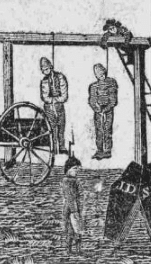 A 1771 a batch of New York paper money was so extensively counterfeited that officials proposed printing an illustration of a hanging on all printed money. The plan was never carried out, but they hoped the scene of a man hanging from the gallows would have profound impact.
A 1771 a batch of New York paper money was so extensively counterfeited that officials proposed printing an illustration of a hanging on all printed money. The plan was never carried out, but they hoped the scene of a man hanging from the gallows would have profound impact.
In addition to deadly prosecutions, officials devised ever more sophisticated methods to thwart counterfeiters. Engravers used complex symbols and marks to make identifying genuine bills from counterfeits easier. Still, the relatively poor quality of printed bills generally meant that the average person was easily duped. As it does today, money often changed hands with little notice of whether it was real or fake.
To read the complete article, see:
Tis' Death to Counterfeit: New England Counterfeiters in NY
(https://newyorkalmanack.com/2018/04/18th-century-warning-tis-death-to-counterfeit/)
To read the earlier E-Sylum article, see:
COUNTERFEITS IN MILWAUKEE AND MINNEAPOLIS
(https://www.coinbooks.org/v23/esylum_v23n23a36.html)
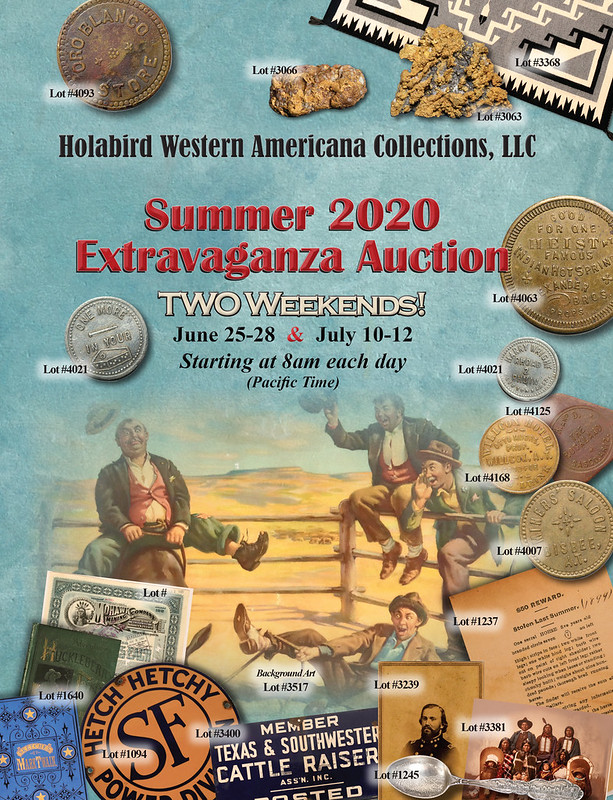
MORE ON THE QUINT MINT
Regarding the "Quint Mint" of Philadelphia, Dave Schenkman mentioned a June 1972 TAMS Journal article by David Gladfelter. Independently, Gladfelter submitted these notes. Thank you! -Editor
The Quint Mint article reminded me of a piece I wrote about this company for the TAMS Journal many years ago. I dug out a file I haven't looked at in 30 years or more. There was a photo of Silas Quint, a copy of his signature, and a product catalog.
There were also a couple of stencils made by Silas circa 1860 that they actually gave me. The stencils wouldn't show up on a scan, but the company made paper impressions for me and those I scanned. They also made copies of much larger stencils – too large to scan, but Krause was able to reduce them to go with the article.
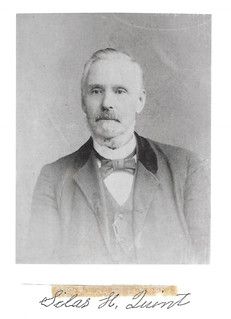
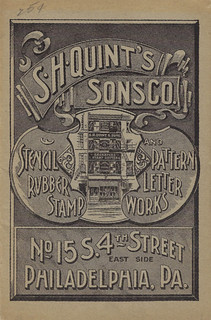
The citation is TAMS Journal 12(3):112-116 (June 1972). This was written back in the age of the typewriter and carbon paper.
I obtained some of their dies for which they had no use – their token and medal press had already been sold. Some of the dies went to auction (with approval of the TAMS board), some were donated to museums and historical societies, and I kept some, making a full accounting to the company and to TAMS. Later, Bowers and Ruddy obtained some of the dies and sold them at fixed prices.
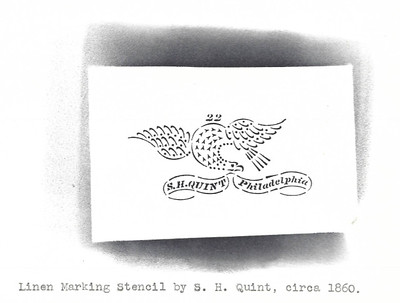
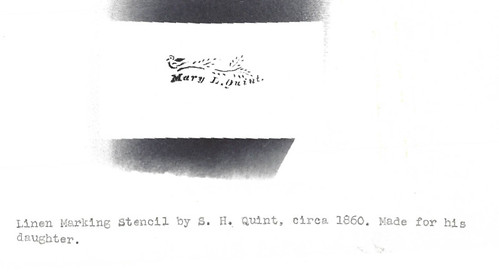
Thanks! -Editor
To read the earlier E-Sylum article, see:
THE QUINT MINT
(https://www.coinbooks.org/v23/esylum_v23n23a23.html)
MORE ON WHITMAN CHECKLISTS
David Luftig shared these images of a Whitman Checklist distributed by Celestial City Coin Co., of Pekin, IL. -Editor
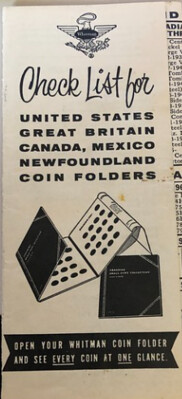
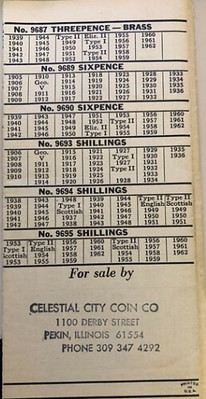
Bill Daehn submitted these thoughts and images. -Editor
I saw the item about the Whitman Check List in last week's The E-Sylum. I too have one of these. The “for Sale by” area contains the rubber stamp of Lucky Coin Company in Easthampton, Massachusetts. I also have a plastic magnifier from Lucky Coin Co.
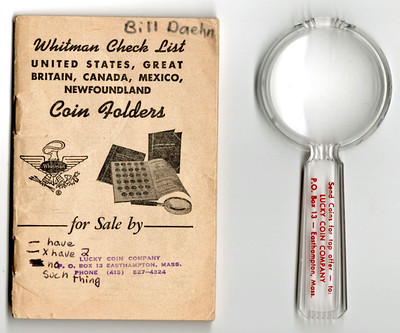
The back page of my checklist has “Form 9” printed on it. This version was apparently printed about 1964. For the current US coins, the latest dates printed on the list are for the 1965 coins and include listings for 1965-D coins---which of course were never minted as the mint did not place mintmarks on the 1965 coins. As my notes on the cover page indicate, I came up with my own system of coding, and for the coins that don't exist (the 1965-D pieces), I obliterated the listing with heavy ink markings.
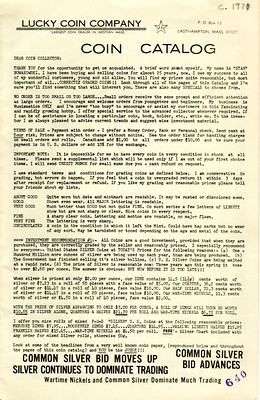 I would have received this list in about 1968 (when I started collecting), and from the markings inside, it appears that I was still using it as late as 1973.
I would have received this list in about 1968 (when I started collecting), and from the markings inside, it appears that I was still using it as late as 1973.
Lucky Coin Company used to advertise in Boys Life magazine----the monthly magazine of the Boy Scouts of America. I received the checklist and magnifier after replying to an ad. I also still have a Lucky Coin Co. fixed price list. The list is undated, but is likely from 1971.
Thanks! -Editor
To read the earlier E-Sylum article, see:
WAYNE'S NUMISMATIC DIARY: JUNE 7, 2020 : Whitman Coin Checklist
(https://www.coinbooks.org/v23/esylum_v23n23a28.html)
MORE ON THE C. E. HORNS COUNTERSTAMP
Tom Schoeck submitted these notes on a counterstamped coin illustrated last week. Thanks! -Editor
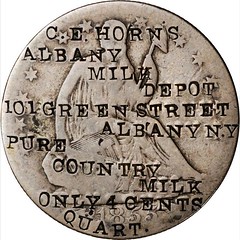

I'm very “local” to Albany so I had no trouble digging a little deeper into one of the auction lots you highlighted in the current (6/6) E-Sylum.
Specifically, that would be Lot 178 in the June 2020 Stack's Bowers Francesca collection sale, the C.E. Horns Milk Depot c/s on an 1855-O US half-dollar.
The depot's address is still there, now located in the shadow of our busy Interstate 787, which runs about 15 miles north-south parallel to the Hudson River to connect Albany, Troy, and a few other localities to one another and to the New York State Thruway. I-787 is elevated at the point where 101 Green Street faces it…a real wall of concrete, access ramps, parking lots, alas.
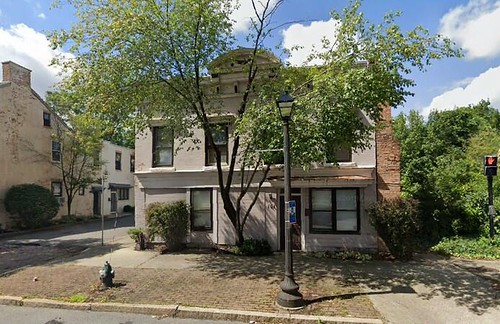
Local real estate records show the current building has been at that address since 1830, so this is where that half-dollar originated... and where it was perhaps even actually counterstamped! As an aside, this address is located in a mainly residential neighborhood now called “The Pastures,” only a few blocks from the mansions of the Schuylers (Alexander Hamilton's in-laws), Van Rensselaers, and other major historical figures from the pre-Revolutionary period forward.
Best to all the inmates at The E-Sylum, and wash your hands!
To read the earlier E-Sylum article, see:
STACK'S BOWERS FRANCESCA SALE SELECTIONS : Lot 178: C. E. Horns Counterstamp
(https://www.coinbooks.org/v23/esylum_v23n23a25.html)
HINDSIGHT ON THE COREY'S OINTMENT COUNTERSTAMP
Bill Groom offers these notes on an interesting counterstamp. Thanks! -Editor
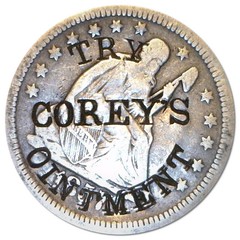 Some time ago, I penned an article on the
TRY COREY'S OINTMENT counterstamps.
I expressed my belief therein that this issue was most likely produced by Dr. Medad S. Corey of western NY. Dr. Corey was granted a patent in 1883 for his ointment to treat piles. He apparently sold the patent to an Ohio company which marketed the product for many years thereafter as “The Eureka Pile Ointment.” Dr. Corey had abandoned his medical office in Fredonia, but he maintained his practice at his country store in Hamlet, twelve miles distant.
Some time ago, I penned an article on the
TRY COREY'S OINTMENT counterstamps.
I expressed my belief therein that this issue was most likely produced by Dr. Medad S. Corey of western NY. Dr. Corey was granted a patent in 1883 for his ointment to treat piles. He apparently sold the patent to an Ohio company which marketed the product for many years thereafter as “The Eureka Pile Ointment.” Dr. Corey had abandoned his medical office in Fredonia, but he maintained his practice at his country store in Hamlet, twelve miles distant.
The Fredonia Censor, NY 2-13-1884
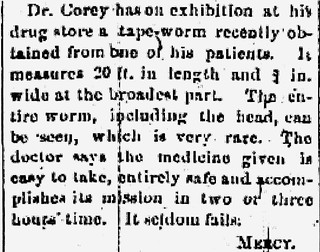 In further researching Dr. Corey, I stumbled upon a rather intriguing, local news article, pictured to the left. I'd previously read that Dr. Corey maintained a herb garden behind his store. Judging from this article, it seems that the good doctor was given to concocting natural remedies. The success of his worm medicine evidenced a rather remarkable ending!!
In further researching Dr. Corey, I stumbled upon a rather intriguing, local news article, pictured to the left. I'd previously read that Dr. Corey maintained a herb garden behind his store. Judging from this article, it seems that the good doctor was given to concocting natural remedies. The success of his worm medicine evidenced a rather remarkable ending!!
This all makes me wonder if Corey may have issued another counterstamp; perhaps, entitled COREY'S WORM DISPATCHER !?

SO-CALLED DOLLAR LUCITE HOLDERS OFFERED
Here's the press release for a new series of holders for so-called dollars. -Editor
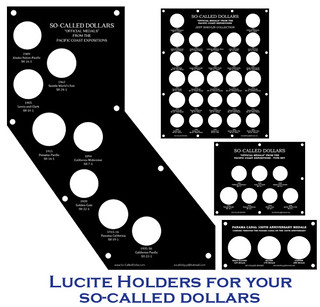 Jeff Shevlin, nationally recognized expert on so-called dollars, has available four different types of Lucite holders to store and display so-called dollars, which are historical U.S. medals that commemorate events in the United States history.
Jeff Shevlin, nationally recognized expert on so-called dollars, has available four different types of Lucite holders to store and display so-called dollars, which are historical U.S. medals that commemorate events in the United States history.
“It is exciting to introduce a new product that will allow collectors to showcase and display their collections”, Shevlin said. “There are four different holders related to my latest award-winning book So-Called Dollars from the Pacific Coast Expositions. These holders will store the official U.S. Mint medals, struck at the eight expositions, that were held on the West Coast”.
There are four different Lucite Holders to store and display your so-called dollars.
- "Pacific Coast Set" holder in the shape of the West Coast, has one hole for the official medal from each exposition. Large 10" x 12" format with eight holes. $49
- "Complete Set" holder has 27 holes for the different compositions of the official medals, silver, gold-plated, etc. Large 10" x 12" format with 27 holes. $49
- "Type Set" holder has one hole for the official medal from each Exposition. 6" x 8" format with 7 or 8 holes. $29
- "Three Hole Set" holder 6" x 3" format with 3 holes. $19
- "Custom" holders can be ordered in any size to store and display any collection. Minimum order of five for any custom holder. Prices vary.
For an additional $5 any holder can be customized with your name added to the holder, such as "JEFF SHEVLIN COLLECTION". Shipping is $5.
To order contact Jeff Shevlin at SoCalledGuy@hotmail.com, call (916) 955-2569 or visit the web site www.So-CalledDollar.com
VOCABULARY TERM: MEDALLIC ART
Dick Johnson submitted this entry from his Encyclopedia of Coin and Medal Terminology. Thanks. -Editor
Medallic Art. A class of art that can reproduce bas-relief images, often including lettering, expressed as medals, medallions, plaquettes or similar objects. Because of the similarity of manufacture, medallic art could also include coins, but this is more aptly termed numismatic art (as it is in this book). Medallic art may be included in the class of glyptic art, which also includes engraved objects like gems, seals and cameos (only some of which are included in this book – those that are, or can be, reproduced).
Medallic art includes small bas-relief objects made from patterns created by one of several sculpture methods: some by casting from an exact size pattern, or, from an oversize model that is pantographically reduced – this process cuts a die to strike the item – or even hand engraving is used to make or refine the pattern. These are then reproduced in quantity, by casting or striking.
Medallic art characteristics. Exemplified by art medals medallic art is created by artists rather than coining technicians. The medallic artist has at his disposal a palette of techniques for medallic creations differing greatly from those of the coin artist. In addition to its design (in a wide range of styles), the medallic artist employs height of relief, texture of the surfaces, and an expanded use of symbols and symbology. He also has a far greater determination of the item's shape, whether it has openwork, and its finish or patina, among dozens of other characteristics (all discussed in this book). These are all techniques available to the medallic artist. Medallic art is a field of art unlike any other. It has the recognized ability to commemorate, memorialize, document, or honor a person, place or event. It creates objects that are capable of recording such pictures with captions as miniature works of art. Better yet, these highly desirable objects last forever. Like coins and numismatic art, medals and medallic art are also noted for their longevity: one generation talking to another generation many years or centuries apart, in a very artistic manner.
Medallic art is very close to sculpture, because of its three dimensionality. It also has a heritage or outgrowth based on engraving and diesinking – hand engraving at first – but machine engraving as the field progressed (and machine engraving requires a sculptor's model). While it is a marriage of art to coining, medallic art is also an art medium that is very democratic: anyone can have a medal made! Or, by individual casting, anyone can make their own medal.
Numismatic art versus medallic art. The art work – designs, models and patterns – for coins have many more restrictions than the art work required for medallic items. The coin designer must keep in mind dozens of these limitations when preparing a new coin design. A coin must be a certain size, have a prescribed weight, must be an exact shape (most often round), have a denomination, bear required mottoes or other lettering, the height of relief is extremely limited, it must adhere to the laws of coinability, if must be suitable for vending machines, it must bear a nationalistic design and be recognizable by its citizens, it must have a certain propriety, the die to strike it must have a certain camber (and a basin in its model), it must not have congruent mass (heavy areas of relief back-to-back), its surface must have a certain resistivity to trigger fare box and turnstiles. The list appears endless.
Medallic art has none of these restrictions. Medallic art can be created for anyone – not just for a nation – thus being far more democratic. Medallic art can be freer and liberated in its design and conception! A medal can picture and its inscriptions can say virtually what its issuer wants (short of slandering a living person). It is a miniature work of art to commemorate, to memorialize, to celebrate, to preserve an image -- of a person, thing or event -- for future generations. Medallic art has great longevity. As an art object it is far more apt to be saved, preserved, venerated by succeeding generations.
A special class of medallic art – MEDALLIC OBJECTS – goes even further in this discarding of restrictions. Medallic objects, created only within the last few decades, purposely break the rules of coin and medal design, overcome medallic prejudice in addition to all technical restraint, to become aesthetic objects for the eye to behold.
Medallic art practitioners. The greatest practitioners of medallic art has always been the French. The Paris Mint must be celebrated for their support and encouragement of this field. They have issued, even when it was not politically correct or economic to do so, hundreds of fine art medals each year. Not only have they issued art medals created by their own countrymen, but also from fine art medalists from around the world.
This support reached a pinnacle under the direction of Mint Director Pierre de Haye. In the 1960s during his administration he was issuing, on average, one new art medal a day. Subjects covered the spectrum of man's endeavor, styles were as broad as the hundreds of artist's work he was producing. To his credit, and a few inspired artists, they even developed a new art medium, the medallic object.
Collecting medallic art. Highly artistic medal collecting parallels that of medal collecting in general. Collectors seek specimens that can be included in their chosen topic that serves as a guide for their collecting. However, since “art” itself can be a topic, some medal collectors select artistic medals and study their styles, the artists who create these and the occasions which spawn their creation.
Some collectors of paintings have turned to collecting medallic art when their walls are full, any further space is limited and their passion for acquiring beautiful things still burns within them. Medal collecting is ideal because of the small space they occupy, their permanence and the ease of housing (cabinets are ideal for storing a medal collection). Coin collectors have turned to medal collecting when “dates and mintmarks” are too predictable and no longer hold their attention.
Medallic Art Company. A company by this name was active in the 20th century in America. Incorporated in New York City in 1910, Medallic Art Company rose from a workroom for a sculptors' assistant, Henri Weil, who had imported the first Janvier to America (for a previous employer, Deitsch Brothers, that produced medals 1907-1910). With his brother, Felix Weil, they built the business, along with a third associate who joined them in 1919, Clyde Curlee Trees. This firm struck the major art medals in America from the first World War forwards. This firm also created the most prestigious award medals including the Pulitzer Medal for journalism, the George Foster Peabody Medal for broadcasting, the National Medal of Science, the Presidential Medal for Freedom, the Congressional Medal of Honor, and the Newberry and Caldecott Medals in the field of literature. Also they were dominant in the private manufacture of official U.S. presidential inaugural medals.
In 1930 it further supported the medallic field by sponsoring The Society of Medalists, which issued two art medals a year spawned by famed American sculptors. In 1972 the firm moved from New York City to Danbury, Connecticut, in time to satisfy the tremendous demand for bicentennial medals. (The present author was director of research for the firm at this time.) A decade after the dropoff of business, following the American bicentennial, the assets of the firm were purchased by Tri State Minting, moved to Sioux Falls, South Dakota, and ultimately removed to Dayton, Nevada in 1997.
Development of A Theme Daniel Chester French was commissioned to prepare the Catskill Aqueduct Medal in 1922. He chose a female head as his theme and modeled it in classical style. He included a border of dentiles that further emphasized the classical treatment. It was sponsored by the American Numismatic Society (to their credit!) and issued in three-inch cast size in bronze and silver. It was also struck in dollar size 1 1/2-inch bronze and silver and became a so-called dollar.
In 1933 the president of Medallic Art Company which had produced the medal, Clyde Curlee Trees, chose the female head from the obverse of this medal to become his company's trademark. He eliminated the classical border of dentiles but kept the female head intact. He ordered dies made in five different sizes (without the border) and the design became famous for its appearance in advertising, stationery, nameplates, business cards, even as a mintmark (first used by the firm in 1968).
In honor of its creator, Daniel Chester French, the trademark became known as the “French Head.” Also in a fortunate confluence of words and names, it also honored the native country of Medallic Art founders and the source of medallic art as an art medium.
The original event honored the completion of the aqueduct (from the Catskills to New York City). For French to have created such an artistic design is sheer genius. For medallic artists everywhere it is an inspiration to create their finest artistic work despite, perhaps, the subject. After all, the original medal was created to honor a water pipe!
References:
A38 {1979} Jones.
O13 {1945} Anonymous.
Looking for the meaning of a numismatic word, or the description of a term? Try the Newman Numismatic Portal's Numismatic Dictionary at: https://nnp.wustl.edu/library/dictionary
Or if you would like a printed copy of the complete Encyclopedia, it is available. There are 1,854 terms, on 678 pages, in The Encyclopedia of Coin and Medal Technology. Even running two a week would require more than 19 years to publish them all. If you would like an advance draft of this vital reference work it may be obtained from the author for your check of $50 sent postpaid. Dick Johnson, 139 Thompson Drive, Torrington, CT 06790.
CHARLES E. LEAL (1870-1894)
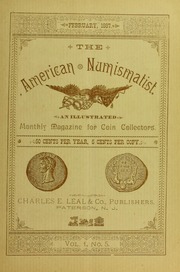 Leal, Charles E. (1870-1894), 149 Ellison Street, Passaic County, Paterson, New Jersey.
Leal, Charles E. (1870-1894), 149 Ellison Street, Passaic County, Paterson, New Jersey.
Son of John Rose Leal (1828-1882), a physician and Mary E. Leal, nee Laing (1838-?). His parents were married on August 28, 1855 at Andes, New York. His father was born in Andes, New York, and his mother in Scotland.
He had an older brother John Laing Leal (1858-1914) his senior by 12 years, who was also born at Andes, New York, became a noted physician who, in 1908, introduced chlorinated drinking water into the United States.
His family was active in the First Presbyterian Church at Paterson and in May 1886 they were charter members of the Church of the Redeemer at Paterson under the Presbytery of Jersey City.
In 1884 young Charles, only 14 years old, ran an ad selling Liberty Head nickels and revenue stamps, and postal marks. A few years dealing coins as a neighbor of David Proskey, who lived one mile away at 448 River Street, Paterson, N.J., he commenced publishing at the age of 16 years old, The American Numismatist. Publisher of The American Numismatist from July 1886 to December 1887, with 12 issues published from September 1886 to December 1887. Leal originally sent his copy to be printed for The American Numismatist to New Market, New Hampshire to be printed by F. H. Pinkham, but changed printers beginning in February 1887 to Frank E. Essex in Paterson, New Jersey. After discontinuing The American Numismatist he immediately began publishing the Paterson Evening Telegram. Leal discontinued this paper and in August 1888 began publishing The Paterson Republican. In February 1891 he published his first issue of The Collectors Magazine. He died on October 18, 1894 at the age of 24 years. Tragic, but true. He is buried in the Cedar Lawn Cemetery, Paterson, New Jersey.
To read the complete article, see:
LEAL, CHARLES
(https://sites.google.com/a/numismaticmall.com/www/numismaticmall-com/leal-charles)
To read The American Numismatist on NNP, see:
The American Numismatist
(https://nnp.wustl.edu/library/publisherdetail/511224?Year=1887)
To read earlier E-Sylum articles, see:
THE AMERICAN NUMISMATIST
(https://www.coinbooks.org/esylum_v06n06a11.html)
THE NUMISMATIST IS THE NUMISMATIST AGAIN
(https://www.coinbooks.org/esylum_v10n52a09.html)
NATIONAL EMERGENCY LIBRARY CLOSES
The Internet Archive has announced the closing of the "National Emergency Library", an online resource for access to books owned by institutions participating in IA's Open Library program. Here's an excerpt from the press release - see the complete version online. -Editor
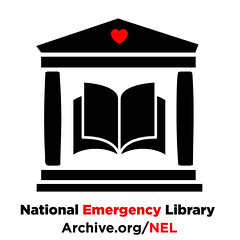 Within a few days of the announcement that libraries, schools and colleges across the nation would be closing due to the COVID-19 global pandemic, we launched the temporary National Emergency Library to provide books to support emergency remote teaching, research activities, independent scholarship, and intellectual stimulation during the closures.
Within a few days of the announcement that libraries, schools and colleges across the nation would be closing due to the COVID-19 global pandemic, we launched the temporary National Emergency Library to provide books to support emergency remote teaching, research activities, independent scholarship, and intellectual stimulation during the closures.
We have heard hundreds of stories from librarians, authors, parents, teachers, and students about how the NEL has filled an important gap during this crisis.
Ben S., a librarian from New Jersey, for example, told us that he used the NEL “to find basic life support manuals needed by frontline medical workers in the academic medical center I work at. Our physical collection was closed due to COVID-19 and the NEL allowed me to still make available needed health informational materials to our hospital patrons.” We are proud to aid frontline workers.
Today we are announcing the National Emergency Library will close on June 16th, rather than June 30th, returning to traditional controlled digital lending. We have learned that the vast majority of people use digitized books on the Internet Archive for a very short time. Even with the closure of the NEL, we will be able to serve most patrons through controlled digital lending, in part because of the good work of the non-profit HathiTrust Digital Library. HathiTrust's new Emergency Temporary Access Service features a short-term access model that we plan to follow.
The press release states that the closing was moved up because four commercial publishers filed lawsuits against Internet Archive. It could well be that provoking a lawsuit was part of IA's intent. It is unlikely that the suits will be dropped just because the NEL has closed. Publishers want to punish IA for allowing free access to their copyrighted works, and IA likely wants a test case that would pave the way for general acceptance of a more constrained form of controlled digital lending. -Editor
Controlled digital lending is how many libraries have been providing access to digitized books for nine years. Controlled digital lending is a legal framework, developed by copyright experts, where one reader at a time can read a digitized copy of a legally owned library book. The digitized book is protected by the same digital protections that publishers use for the digital offerings on their own sites. Many libraries, including the Internet Archive, have adopted this system since 2011 to leverage their investments in older print books in an increasingly digital world.
Two phrases I've used in recent months both apply to this episode: "Never let a good crisis go to waste" and "Crises have a way of accelerating the inevitable". Internet Archive helped homebound readers and researchers while at the same time forcing publishers to take legal action; meanwhile, digital lending has already been done by libraries for many years in a very limited way; Internet Archive has stretched the boundaries to the breaking point, but in the end hopefully there will be a settlement that all sides will be able to (or forced to) live with, and there will be an accepted framework for libraries (including hobby organizations like the American Numismatic Association, American Numismatic Society and American Philatelic Society) to make their vast book collections more readily accessible to members and users. -Editor
To read other articles on the topic, see:
Internet Archive Will End Its Program for Free E-Books
(https://www.nytimes.com/2020/06/11/books/internet-archive-national-emergency-library-coronavirus.html)
Internet Archive ends “emergency library” early to appease publishers
(https://arstechnica.com/tech-policy/2020/06/internet-archive-ends-emergency-library-early-to-appease-publishers/)
To read the earlier E-Sylum article, see:
NATIONAL EMERGENCY LIBRARY ANNOUNCED
(https://www.coinbooks.org/v23/esylum_v23n14a25.html)
INTERNATIONAL REFORMATION NUMISMATIC DAY
Rev. Dr. Daniel Harmelink of the International Association of Reformation Coins and Medals passed along this reminder. Thank you. -Editor
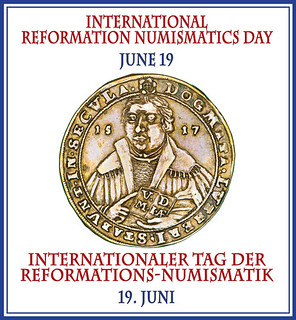 A friendly reminder that June 19 is International Reformation Numismatic Day.
A friendly reminder that June 19 is International Reformation Numismatic Day.
Much has happened to promote this important area of numismatics - even after the 500th anniversary of the Reformation on October 31, 2017.
The IARCM continues to promote projects that further the discipline of Reformation numismatics.
• Ebenezer / Schlegel / Hilaria is scanned and waiting someone who has the skill to translate the text into English. This was the highest priority of Dr. Rainer Opitz when I talked to him before his untimely death on February 7, 2019.
• We continue to encourage the development of a comprehensive index for the 6-volume Opitz and 2-volume Brozatus catalogs.
• We are also beginning to explore the possibility of 3D scans of Reformation coins and medals to create a three dimensional catalog online.
Daniel adds:
"June 19 was chosen because it is Christian Junker's birthday. He is the author of the 1706 book “Reformatio in Nummis,” an important presentation of the hundreds of Luther and Reformation coins and medals struck in anticipation of the 300th anniversary of the Reformation."
For more information, see:
International Association of Reformation Coins and Medals
(http://www.iarcm-igmmr.org/)

HOLABIRD SUMMER 2020 SALES
Here's the press release for the upcoming Holabird Summer 2020 auction sales. Lots of great numismatic items here. Look for numismatic selections in future issues. -Editor
HOLABIRD WESTERN AMERICANA COLLECTIONS' MASSIVE 7-DAY SUMMER 2020 EXTRAVAGANZA AUCTION WILL BE HELD ACROSS TWO SEPARATE WEEKENDS
The live and online auction is packed with numismatics, mining, railroadiana, Native Americana and more and stars the John Reynolds, Bart Landinger, Ben Fauver and Ken Prag collections
A Summer 2020 Extravaganza Auction so massive it is being spread over two separate weekends, two weeks apart, is planned for June 25-28 and July 10-12 by Holabird Western Americana Collections, LLC, live and online, with start times each day of 8am Pacific time. The sale features a number of important collections of Americana – over 4,800 lots in all.
The auction is packed with numismatics, mining, railroadiana, Native Americana and more. Online bidding will be facilitated by iCollector.com, LiveAuctioneers.com, Invaluable.com, AuctionMobility.com and Auctionzip.com. Telephone and absentee bids will also be accepted. For those planning to attend live, Holabird's gallery is located at 3555 Airway Drive in Reno.
The auction features several important collections, offered in part now and in upcoming sales. An example is the John Reynolds collection, parts of which were offered in two prior sales. On Days 1 and 4, items from Reynolds's 50+-year Californiana collection will come up for bid, as will a variety of vintage historical baseball and boxing cards, all graded, circa 1920 thru 1950.
Also on Day 4, the Bart Landinger collection of Arizona material, mostly trade tokens but to also include California and western tokens and scrip, will be sold. Mr. Landinger garnered many great rarities in his many travels, looking at collections over the years. He was a friendly face at Western token shows. Tragically, he recently passed away. His collection is a celebration of life.
Benjamin Fauver literally wrote the book on tokens, and he especially favored gaming counters (which resembled American gold coins and have morphed into the gaming chips we know today). He also collected foreign counters (Jetons and the like) that were made for years, mainly in Western Europe. Parts of the Fauver American Counter Collection will be offered on Days 1 and 4 and will feature more than 10,000 pinback buttons.
The auction will feature maps not generally seen, from a massive Western map collection; gold and minerals, to include gold specimens from two Western collections; part of a Sam Clemens (Mark Twain) library that will highlight a massive Western history library spread across the sale; an Idaho real photo postcard collection; and a group of early signed Norman Rockwell prints.
Day 1, on Thursday, June 25th, will contain California ephemera (a continuation of the John Reynolds collection), parts of the Idaho real photo postcard collection, Western maps (also in other places in the catalog), historical and vintage pinbacks from the Fauver collection, a vintage doll collection, an American Directory collection and the Sam Clemens (Mark Twain) collection.
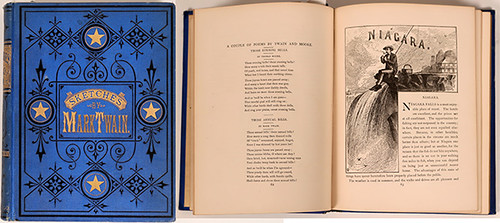
Day 1 lots will feature a rare Frontier Gasoline (“Rarin'-to-Go”) enamel cowboy sign, six feet in diameter, circa 1958-59 (est. $6,000-$12,000); a first edition, second state of Sketches New and Old (1875), illustrated throughout by Samuel Clemens, or “Mark Twain” (est. $1,000-$2,000); and an 1885 edition copy of Twain's classic, Adventures of Huckleberry Finn (est. $700-$900).
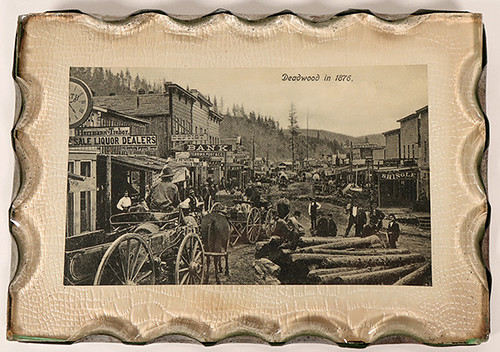
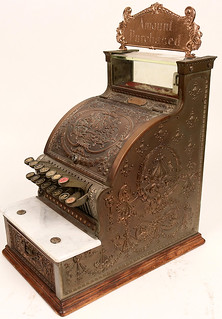 Other Day 1 lots will include an 1876 photo of the Wild West town of Deadwood (S.D.), framed under glass (est. $800-$1,200); an SOAS Photo Cine Optics “Make Your Own Headline” print press (N.Y., 1970s, est. $600-$1,500); a collection of about 59 Brinn's dolls, all in original boxes (est. $600-$1,500; and a circa 1911 National Cash Register, candy store model (est. $500-$800).
Other Day 1 lots will include an 1876 photo of the Wild West town of Deadwood (S.D.), framed under glass (est. $800-$1,200); an SOAS Photo Cine Optics “Make Your Own Headline” print press (N.Y., 1970s, est. $600-$1,500); a collection of about 59 Brinn's dolls, all in original boxes (est. $600-$1,500; and a circa 1911 National Cash Register, candy store model (est. $500-$800).
Day 2, on Friday, June 26, will feature a railroad badges and passes collection, a continuation of the Ken Prag railroad stocks and bonds collection, stagecoach passes (includes Sonora to Bodie), railroad and steamer passes, cap badges, and mining stocks and bonds from various collections.
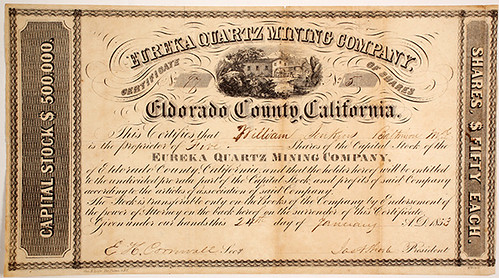
Top lots from Day 2 will include a stock certificate for the Eureka Quartz Mining Company (Georgetown, Calif.), for five shares, issued to a William Jenkins of Baltimore and dated July 24, 1853, signed by officers in the company (est. $800-$2,000); and a 1917 Liberty Loan bond for $50, in very fine condition, showing Lady Liberty and Thomas Jefferson (est. $1,000-$1,500).
Day 3, on Saturday, June 27, will showcase minerals and native gold nuggets and rarities, mining artifacts from an old collection, mine maps, Native Americana (to include rugs, art, jewelry and references such as a Chinook Directory, cowboy collectibles, the previously mentioned Norman Rockwell early signed prints, and bottles and saloon items from various Western collections.
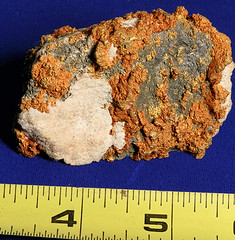 Gold specimens will undoubtedly dominate the list of Day 3 top lots. Offered will be a large native crystalline gold in quartz specimen with lead and silver sulfides, mined in the 1950s and in need of professional curation, weighing 12.32 troy oz. (est. $10,000-$14,000); and a native gold in quartz specimen, also mined in the 1950s in the US, 3.48 troy oz. (est. $3,000-$5,000).
Gold specimens will undoubtedly dominate the list of Day 3 top lots. Offered will be a large native crystalline gold in quartz specimen with lead and silver sulfides, mined in the 1950s and in need of professional curation, weighing 12.32 troy oz. (est. $10,000-$14,000); and a native gold in quartz specimen, also mined in the 1950s in the US, 3.48 troy oz. (est. $3,000-$5,000).
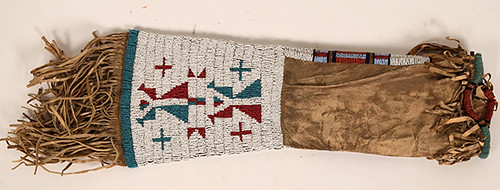
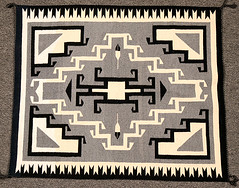 Other Day 3 star lots include a beautiful Northern Plains fringed beaded peace pipe (Chanupa) bag from the early 1900s, with the beading all intact and the hide well worn (est. $1,500-$3,000); and an exquisite Toadlena Two Grey Hills (New Mexico) weaving, 42 inches by 36 inches, in excellent condition, with the four corners hooked, as is the center diamond (est. $1,500-$3,000).
Other Day 3 star lots include a beautiful Northern Plains fringed beaded peace pipe (Chanupa) bag from the early 1900s, with the beading all intact and the hide well worn (est. $1,500-$3,000); and an exquisite Toadlena Two Grey Hills (New Mexico) weaving, 42 inches by 36 inches, in excellent condition, with the four corners hooked, as is the center diamond (est. $1,500-$3,000).
Day 4, on Sunday, June 28, will be bursting with coin hoards, cents to nickels with rare dates from the Indian Trading Post in Russellville, Arkansas; so-called dollars; gaming counters, the start of the massive Benjamin Fauver collection; Exposition collectibles; medals; currency and scrip; and sports items, to include the large baseball and boxing collection of John Reynolds.
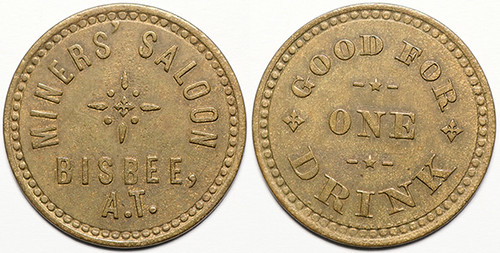
Day 4 will also be bursting with tokens from the Bart Landinger Arizona collection and the California and Western token and scrip collection. One noteworthy token is from the Miner's Saloon in the mining town of Bisbee, Arizona (1880s, est. $600-$1,000). The Miner's Saloon was quite popular and Bisbee was once the largest city between New Orleans and San Francisco.
Days 5 thru 7 are still being cataloged, but it can be reported that Day 5 (July 10) will feature general Americana collectibles and a postcard collection from California and the West; Day 6 (July 11) will contain a wide variety of mining stocks; and Day 7 (July 12) will include political buttons from the Fauver collection; sports (baseball, boxing, Olympics), firearms collectibles (no guns will be sold); art in all categories here; historical maps; and an historical reference library.
Color catalogs are available by calling 1-844-492-2766, or 775-851-1859. Also, anyone owning a collection that might fit into an upcoming Holabird Western Americana Collections auction is encouraged to get in touch. The firm travels extensively throughout the U.S., to see and pick up collections. Last year it visited Boston, Florida, Seattle and New York, among other destinations.
Holabird Western Americana Collections is always in the hunt for quality Americana and coin consignments, bottles, advertising and other collections for future auctions. To consign a single piece or a collection, you may call Fred Holabird at 775-851-1859 or 844-492-2766; or, you can send an e-mail to fredholabird@gmail.com. To learn more about Holabird Western Americana Collections and the online-only Summer 2020 Extravaganza Auction, visit www.fhwac.com.
NUMISMATIC NUGGETS: JUNE 14, 2020
Here's a selection of interesting or unusual items I came across in the marketplace this week. Tell us what you think of some of these. -Editor
Greece Caria Silver Drachm
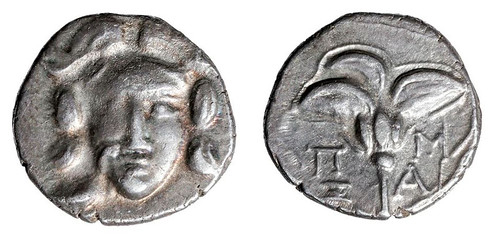
Greece, Caria Islands off Caria, Rhodos, ca. 175 to 150 BCE. AR silver drachm. Obverse: Facing head of Helios. Reverse: Rose, with branches and monograms to either side. Ashton, "The Pseudo-Rhodian Drachms of Mylasa", NC (1992) variety. Size: 0.55" W (1.4 cm); 2.8 grams
Provenance: private Ventura County, California, USA collection, acquired from Malter Galleries, California, USA, between 1980 and 1995
A haunting obverse image. From the Artemis Gallery June 11, 2020 sale. -Editor
To read the complete lot description, see:
Greece Caria AR Silver Drachm - 2.8 grams
(https://www.liveauctioneers.com/item/86160114_greece-caria-ar-silver-drachm-28-grams)
Charles I Silver Memorial Medal
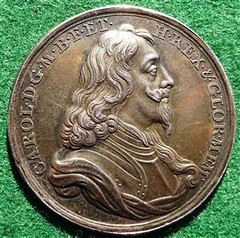
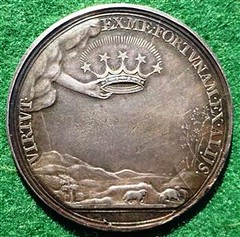
Charles I, silver memorial medal by Roettier (1695), after van Dyck, scarce in silver
Obv: cuirassed bust of Charles I right, draped and with long hair
Rev: a hand holding a crown issues forth from a cloud, above a shepherdless flock of sheep
Condition: Almost extremely fine; Diameter: 34mm
References: MI i 347/201; E 162b; The Medal (Autumn 1989, pp4-5), where Antony Griffiths has shown that these medals were advertised in the London Gazette for 18/22 April 1695
Notes: Charles I was executed on 30th January 1649, and these medals are now thought to date from the reign of William III. The diarist John Evelyn, writing in Numismata, considered the portrait on these medals “incomparably the most resembling his serene countenance when fullest of princely vigour”. The portrait is after van Dyck.
From the site of dealer Charles Riley. See David Pickup's earlier article for more on Charles I. -Editor
To read the complete item description, see:
Charles I, silver memorial medal
(http://www.charlesriley.co.uk/5878.htm)
To read the earlier E-Sylum article, see:
CHARLES I AND THE ROYAL TOUCH
(https://www.coinbooks.org/v23/esylum_v23n23a17.html)
1839 Silly Head Cent
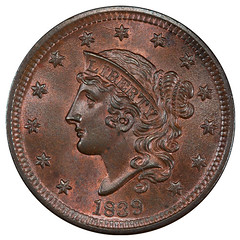
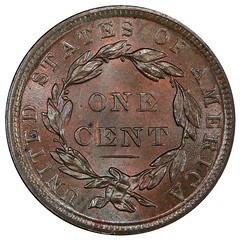
N-9 R.2 1839 Silly Head with CAC. 1748 (TV)
Elsewhere in this issue is a note from Len Augsburger about memorable nicknames for coins and coin varieties. This "Silly Head" cent is from the site of dealer Harry Laibstain. -Editor
To read the complete item description, see:
1839 1C SILLY HEAD N-9 R.2 PCGS MS66BN CAC
(http://hlrc.com/Inventory/CoinViewer?id=869616001&c=23)
Off Center 1930 Buffalo Nickel
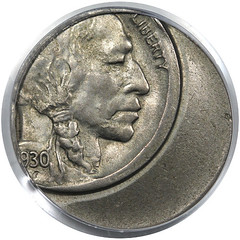
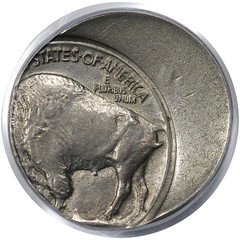
A totally cool, extremely bold, wildly off-center and, importantly, dated Buffalo error the likes of which we have not offered before.
Fabulous coin. Found on John Agre's Coin Rarities Online site. -Editor
To read the complete item description, see:
1930 Buffalo 5¢
35% Off Center
(https://www.coinraritiesonline.com/product/1930-buffalo-5%c2%a2-3/)
1870 Anticosti Island 1/8 Penny Token
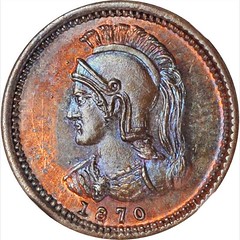
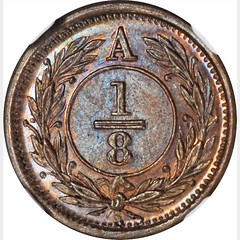
CANADA. Anticosti Island. 1/8 Penny Token, 1870. NGC MS-66 Brown.
KM-Unlisted; Charlton-250. An unusual issue, these tiny bronzes were first attributed to Anticosti Island in 1890 in the Scott Stamp & Coin Co., owing to their prominent "A" at the top of the reverse. The present piece--a stunning Gem with a vibrant color palette--stands at the top of the NGC census.
Interesting piece. I don't think I'd seen this one before. From the Stacks Bowers June 2020 World Collectors Choice Online Auction. -Editor
To read the complete lot description, see:
CANADA. Anticosti Island. 1/8 Penny Token, 1870. NGC MS-66 Brown.
(https://auctions.stacksbowers.com/lots/view/3-N83V3/canada-anticosti-island-18-penny-token-1870-ngc-ms-66-brown)
Bout De L'Isle - Caleche Token
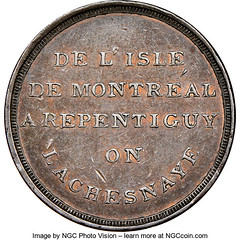
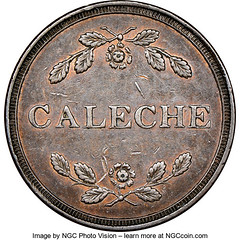
Lower Canada "Bout De L'Isle - Caleche" Token ND (1808) AU53 Brown NGC, Br-538 (R4), BT-9, Robins-29254. Medal alignment. Used to pay tolls for a trip beginning at the Island of Montreal (DE L'ISLE DE MONTRÉAL) by carriage (CALÉCHE). From the Doug Robins Collection of Canadian Tokens, Part II
Another Canadian piece I was unfamiliar with. From the Heritage Auctions site. -Editor
To read the complete lot description, see:
Canada: Lower Canada "Bout De L'Isle - Caleche" Token ND (1808) AU53 Brown NGC,...
(https://coins.ha.com/itm/canada/canada-lower-canada-bout-de-l-isle-caleche-token-nd-1808-au53-brown-ngc-/a/61158-98166.s)
GODS AND GODDESSES ON COINS
I came across this nice article about Gods and Goddesses on coin at the Baldwin's site. Here's an excerpt on Zeus, but see the full article online to learn about Hera/Juno, Apollo, Athena/Minerva, Hercules, Ares/Mars, Hermes/Mercury, Poseidon/Neptune, and Aphrodite/Venus. -Editor
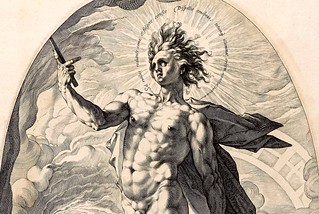 The symbols struck on coins were chosen carefully. They reveal the agendas and priorities of the rulers at the time and, more importantly, represent the ideals by which they ruled.
The symbols struck on coins were chosen carefully. They reveal the agendas and priorities of the rulers at the time and, more importantly, represent the ideals by which they ruled.
Mythologies of Roman and Greek deities were used to provoke associations between the ruler's sovereignty and the divine powers of the gods and goddesses that appeared on their coins.
ZEUS/JUPITER
GOD OF THE SKY AND THUNDER
Zeus was the son of Cronus, a Titan ruler overcome with fear of being overthrown by his offspring. As a result of this obsession, Cronus devoured all his children as soon as they were born but his sixth son survived and freed his siblings including Poseidon and Hades with whom he divided dominion of the world.
While he was married to Hera, Zeus had numerous mistresses and many heroic offspring including Athena, Apollo, Artemis, Hermes, Persephone, Dionysus, Perseus, Heracles, Helen of Troy, Minos, and the Muses.
Zeus's symbols include the thunderbolt, eagle, bull and oak. As the ruler of all gods, he was the most important deity in official religion and came first when rulers paid their respects and religious sacrificies. This is why Jupiter features on numerous Greek and Roman coinage. However, his appearance on the coins of Alexander the Great is probably related to the story of his divine lineage, which his mother Olympias promulgated claiming that a thunderbolt stroke her womb when she was pregnant with Alexander, making Zeus his father.
Zeus seated left on throne on this Kingdom of Macedon silver drachm, holding eagle and sceptre, spearhead behind.
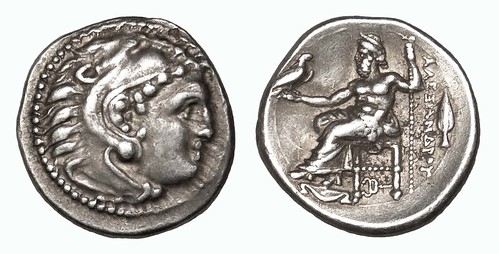
To read the complete article, see:
GODS ON COINS
(https://www.baldwin.co.uk/news/gods-and-goddesses-on-coins/)
COINS OF MACEDON BEFORE ALEXANDER
On June 11, 2020 Mike Markowitz published a CoinWeek article on the coins of Macedon before Alexander the Great. Here's an excerpt, but be sure to see the complete article online. -Editor
ANCIENT MACEDONIANS were marginal Greeks. Although permitted to compete in the Olympics, the Macedonians spoke a distinctive dialect. While their neighbors were creating novel forms of government like democracy, oligarchy and tyranny, the Macedonians clung stubbornly to archaic tribal kingship.
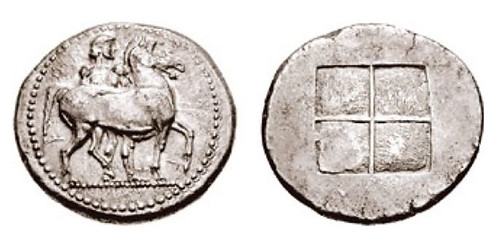
THRACO-MACEDONIAN TRIBES, The Bisaltai. 475-465 BCE. AR Oktadrachm (28.65 gm). C-IS-A-L-T-I-K-WN, a horseman, wearing chlamys and petasos, and holding two spears, leading horse right; EM monogram on horse's rump / Quadripartite incuse square. AMNG III 3; Raymond pl. II, 2; HPM pl. XI, 4; Traité pl. XLV, 2 var. (legend orientation); Gulbenkian 434 (same dies) ($7500)
Alexander the Great was the third king of his name in Macedon, so we might reasonably wonder who those other Alexanders were. Alexander the Meh? Alexander the Agoraphobic? The Argead dynasty to which our Alexander belonged claimed descent from the mythical hero and demigod Herakles, but the list of rulers begins with the legendary King Karanos, c. 808 BCE. Skip around a little more (more than three hundred years later), and we get to the first Macedonian king to issue coins in his own name, Alexander I (ruled 498-454).
Collecting the Macedonians
Auction catalogs and reference books are arranged according to traditional geographic regions. The category “Kings of Macedon” usually appears after listings for Macedon's tribes and independent cities. Collecting the early kings is a challenge, since many of the coins are so rare. The standard reference in English is Hoover (2016), which is still in print (list price $65).
To read the complete article, see:
CoinWeek Ancient Coin Series: Macedon Before Alexander
(https://coinweek.com/ancient-coins/coinweek-ancient-coin-series-macedon-before-alexander/)

ROMAN IMPERIAL COIN LETTERING
Mike Marotta passed along this Coin Talk discussion board post on Roman Imperial coin lettering. Thanks! Here's a short excerpt - be sure to read the complete article online. -Editor
Being a Calligrapher, I have always admired the letterforms employed by the artisan engravers of Imperial Rome on monuments, tombstones, edifices - and coins.
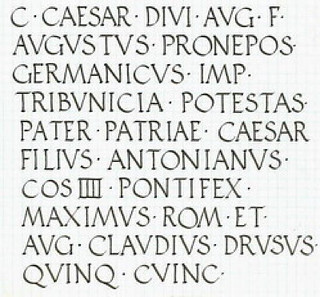
I particularly admire the Inscriptional lettering on the sestertii of the Julio-Claudian Emperors - especially those of Caius (Caligula), Claudius and Nero. The large flans permit elegant letter formation and, in my opinion, the die engravers of that period were especially skilled in rendering very elegant lettering. I eagerly seek out sestertii that have clear and complete inscriptions - the overall coin condition is of secondary importance for me. I have included photos of such coins in this post
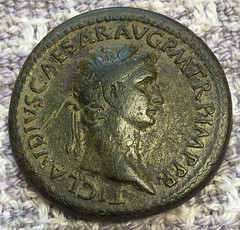
Roman Imperial coin inscriptional letterforms are based on those of CAPITALIS MONUMENTALIS employed by stone cutters for edifices, monuments, tombstones, etc. A fine extant example is found on Trajan's column in Rome and the essential constructs of these letterforms are the models for all Majuscule (Capital) alphabets used in the western world. Stone cutters in particular still employ their distinctive proportions and terminating serifs.
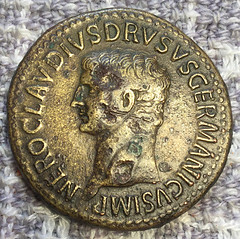
It should be noted that only twenty letters were normally used in the ancient Roman alphabet: A B C D E F G H I L M N O P Q R S T V X. Our modern J and U were not used, their equivalents being I and V respectively. Thus, our modern JULIUS was written IVLIVS. The letter K was seldom used and then only before A. The letters Y and Z were only used when reproducing Greek words. W was not part of the ancient Roman alphabet at all. It was Medieval scribes who formalized the construction models for the letters J K U W Y Z.
To read the complete article, see:
Roman Imperial coin lettering
(https://www.cointalk.com/threads/roman-imperial-coin-lettering.361520/)
I thought of coin lettering when I came across this article on the Letterform Archive of graphic design items. Coins were probably the original graphic design items long before the term was invented. -Editor
San Francisco's Letterform Archive, founded in 2015 by collector Rob Saunders, houses a collection of over 60,000 graphic design items, from as early as 900 CE (labeled “Exodus Manuscript Fragment as Binding”) to as recent as 2019 (a monograph on designer Jennifer Morla published by Letterform Archive).
Letterform, which has been open to the public since its inception, has been expanding the archive's audience through public lectures and workshops, in addition to its postgraduate certificate program in type design. In early April, it went a step further by opening the archive digitally to the public, expanding its reach and availability of its materials — a project long in the making that just happened to coincide with the closure of public spaces across the globe due to the spread of COVID-19.
To read the complete article, see:
A Digital Archive Mines the Depth of Design
(https://hyperallergic.com/569742/a-digital-archive-mines-the-depth-of-design/)
1713 PHILIP V GOLD COB 4 ESCUDOS
This Heritage Auctions press release discusses a nice Philip V gold cob 4 Escudos piece. -Editor
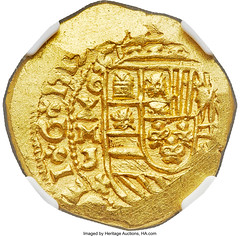
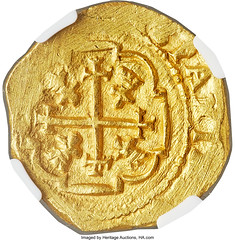
A 1700s Disaster Brings Collectors Modern-Day Treasure
Starting with Christopher Columbus' journey in 1492, Spain suddenly had access to a wide variety of both precious and practical materials found in the New World. This brought both literal treasures such as gold and silver as well as more mundane, yet fascinating, treasures such as new food products.
With the huge influx of emeralds, silver, and more, Spain became enormously wealthy and quickly developed a system of sea transport. A system of convoys was created with the goal of safely transporting these many treasures to their final destination, avoiding pirates and other attackers to transport this booty to the homeland. Called the West Indies Fleet, this has been considered the first permanent transatlantic trade route in history.
A piece of this history can be purchased in Heritage Auctions' August World Coin Auction #3085. The 1715 Treasure Fleet was a convoy of Spanish ships returning to Spain from the new world, laden with treasures of silver and gold. A hurricane struck that tragically destroyed 11 of the 12 ships, killing an estimated 1,500 soldiers. What was a disaster in its day is considered a fascinating event in world history today, having created many collectible coins and objects that were salvaged from the shipwrecks and can be owned by collectors.
One such coin is the 1713 Cob 4 Escudos gold coin that Heritage is auctioning at the ANA. This can be your very own piece of shipwreck history, looking almost as lovely as the day it was made, just 2 years before it sunk (and about 300 years ago now!).
If all of this talk of Spanish treasure and pirates gets you interested in the topic, then the above piece is not your only opportunity to purchase a treasure of your own in Sale 3085! There are both other great Spanish coins of the 1700s and also other treasure ship pieces that will cross the auction block
To read the complete lot description, see:
Philip V gold Cob 4 Escudos 1713 MXo-J MS63 NGC, M...
(https://coins.ha.com/itm/mexico/world-coins/philip-v-gold-cob-4-escudos-1713-mxo-j-ms63-ngc-/p/3085-57012.s)
KING GEORGE'S RECOVERY
David Pickup's latest article in his series on health and coins is about the recovery of King George III. Thank you! We illustrated an example of one of the Recovery medals back in April, and now we have the story. -Editor
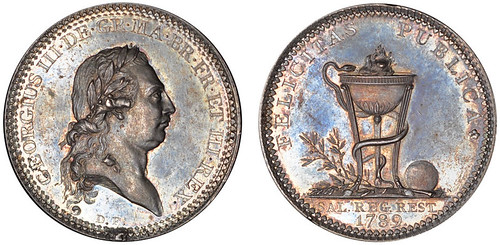
Continuing with stories about health and coins this week we turn to a royal recovery. King George III had a long reign but did not enjoy the best of health. A number of different diagnoses have been suggested including the genetic disease porphyria which can cause mental health symptoms possibly produced by arsenic poisoning or alternatively the mental illness called bipolar affective disorder.
He first became ill in 1765 and had a longer episode in 1788. In an effort to get a cure he went to a Midlands town called Cheltenham Spa to take the medicinal waters but his condition worsened. In November he became seriously ill, sometimes speaking continually for many hours, foaming at the mouth, and repeating himself. Treatment for mental illness even for a king was very basic. It consisted of forcible restraint and chemical poultices to draw out "evil humours".
His bad health led to a political crisis and a debate about who should be Regent. Fortunately George III recovered and the issue was put to one side. It was his idea to have a public celebration although his own government was not keen. The ceremony was intended to be like a coronation service and the king planned part of it himself. The main event was held at St. Paul's Cathedral in London on 23rd April 1789.
Over twenty different types of medallions were issued to mark the event in various sizes and metals. Some very rare ones were presented to senior officials and to Queen Charlotte. Others in gold and silver were presented to the patrons of the “charity children” who attended the church service. Designs featured the coat of arms of London; St Paul's cathedral and another an image of a well at Cheltenham Spa which the king had visited when in search of a cure. (A bit of advertising do you think? They did not mention the fact the the cure had not been successful.)
One of the medals has the inscription,
WHEN WE FORGET HIM MAY GOD FORGET US! Thurlow
Edward Thurlow was a politician who during a speech in the House of Commons said: "God forget me when I forget my sovereign”. Laurence Brown says these were medals were distributed to children in Windsor, eight of whom had been clothed by the Queen for the celebration, and went in procession from the Town Hall to Windsor parish church. Their medals were pierced and hung round their necks on an orange ribbon.
King George was religiously devout and devoted to his family. He was generally popular although best known as the last king of America. Sadly the colonies were not recovered and George's health later deteriorated. He developed dementia, and his sight and hearing with affected. He was unaware of important events including family bereavements and he died in 1820.
To read the earlier E-Sylum articles, see:
VOCABULARY TERMS: CLAD, CLADDING
(https://www.coinbooks.org/v23/esylum_v23n16a18.html)
CHARLES I AND THE ROYAL TOUCH
(https://www.coinbooks.org/v23/esylum_v23n23a17.html)
LEGISLATION TARGETS PURPLE HEART MEDAL SALES
Jim Downey published a letter in the June 11, 2020 MPCGram (Series 21 No. 2422) about legislation pending in the U.S. Congress that would outlaw the sale of Purple Heart medals. With permission, we're republishing it here. -Editor
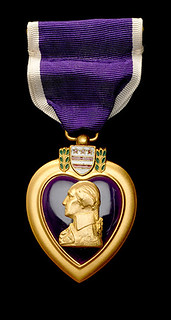 Pending before Congress is the Private Corrado A. G. Piccolo Purple Heart Preservation Act. If passed, the Act will make it illegal for anyone other than the recipient to sell a Purple Heart Medal that has been awarded. The bill has many Congressional sponsors and has been introduced in the both the Senate and House for the last three Congressional Sessions. It was approved in the Senate in the last Congress but has never been moved out of committee in the House. It is currently sitting in committee in both houses and has been since May 2019 when it was re-introduced.
Pending before Congress is the Private Corrado A. G. Piccolo Purple Heart Preservation Act. If passed, the Act will make it illegal for anyone other than the recipient to sell a Purple Heart Medal that has been awarded. The bill has many Congressional sponsors and has been introduced in the both the Senate and House for the last three Congressional Sessions. It was approved in the Senate in the last Congress but has never been moved out of committee in the House. It is currently sitting in committee in both houses and has been since May 2019 when it was re-introduced.
The driving force behind the legislation is Zac Fike and an organization he founded called Purple Hearts Reunited, Inc. Fike's mother obtained the WWII Purple Heart that was awarded to Pvt. Corrado A. G. Piccolo's family after he was killed in action. Fike tracked down members of Piccolo's family and returned the medal to them. He has since made it his mission to return as many Purple Hearts as he can get his hands on.
Along the way, Fike and his supporters have vilified collectors and dealers of military medals as opportunists who seek to make money off other people's valor and death. Dealers in particular are characterized as greedy men who take advantage of old ladies and families by cajoling them out of their family heirlooms for a pittance.
Their attitude is understandable but does not represent reality. When it comes to named and traceable awards, collectors seek to honor the recipients. They often spend a great deal of time and money researching the recipients and preserve their stories in publications and websites. The sad truth is that many of these awards have been voluntarily separated from the recipient's family because there is no longer anyone around who has a direct connection to the recipient and the money received has a greater value to them than the medals.
(I have personal experience reuniting a WWI Purple Heart to the family of the recipient. It left the family when the grandson of the recipient sold it to an antique store shortly after he came into possession of it after his father died. I bought it from a dealer who had traced the name to a member of the 32nd Division which was made up of Michigan and Wisconsin National Guard. I found an obituary that named a woman I had encountered in business as a grandchild of the recipient. She was more than happy to reimburse me what I paid for it to get it back into the family.)
Even so, there is something unseemly about putting a price on this type of material. A KIA award will sell for more than a WIA. But there is inequity even among KIA recipients. The Purple Heart awarded to a Marine who died in the Battle of Iwo Jima will command a greater price than one for a member of the Army who died at Anzio.
Will prohibiting the sale of Purple Hearts solve the problem? This assumes there is a problem in the first place. One only needs to look at the unintended consequences of the Stolen Valor Act to see how misguided this approach is.
Among other things, the Stolen Valor Act made it illegal to sell Medals of Honor. In addition, it is illegal to manufacture copies of, import, export, mail or otherwise receive anything of value in exchange for a Medal of Honor. Has that halted the sale of the medals? Yes, but only in the United States. Collectors and dealers outside the United States are not affected by the law and Medals of Honor continue to trade in foreign auctions and even on the Ebay sites located in other countries like Ebay Canada. This has led to the absurdity of US collectors being unable to acquire the highest US military valor award while non-US collectors can. The UK does not prohibit trade in the Victoria Cross and it arguably values its military patrimony more than the US does.
There are several incongruities in the Private Corrado Piccolo legislation. One is that it only applies to the Purple Heart. It does not apply to any of the valor awards. In other words, it would be illegal to trade in the Purple Heart but not the Distinguished Service Cross, Navy Cross, Silver Star or Bronze Star of a recipient. It also only applies to medals that have been awarded by the government. Copies of US medals are available from non-government sources and the government itself sold off a large stock of WWII era Purple Hearts in the 1980s. How will these be distinguished? And what of the medal that is sold by the original recipient?
Unfortunately, like the Stolen Valor Act, the Private Corrado Piccolo legislation has many supporters in Congress. But these are both "feel good" pieces of legislation that take a very heavy-handed approach to a very minor problem, if it is even a problem at all.
Similar legislation has been attempted before. Please contact the office of your Senator (about S.122) or Representative (about H.R.2911) and let them know your opinion. -Editor
To read the complete bills, see:
H.R.2911 - Private Corrado Piccoli Purple Heart Preservation Act
(https://www.congress.gov/bill/116th-congress/house-bill/2911)
S.122 - Private Corrado Piccoli Purple Heart Preservation Act
(https://www.congress.gov/bill/116th-congress/senate-bill/122)
To read an earlier E-Sylum article, see:
THE PURPLE HEART DETECTIVE: ZACHARIAH FIKE
(https://www.coinbooks.org/esylum_v19n52a13.html)
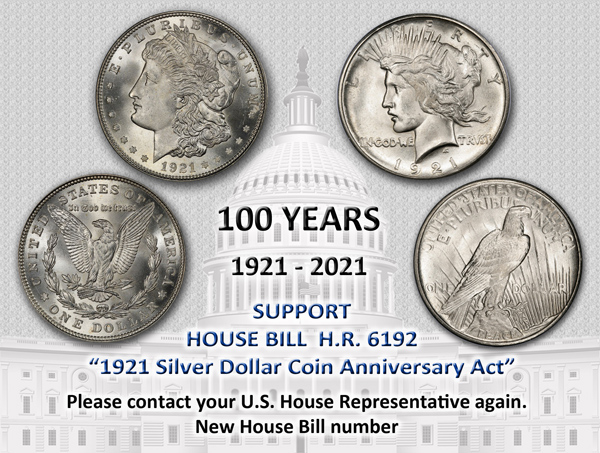
BEAUX-ARTS INSTITUTE OF DESIGN MEDAL
Bob Rhue writes:
"Here's a medal from the Herzog estate I bought that I absolutely love. (it's silver plated bronze)"
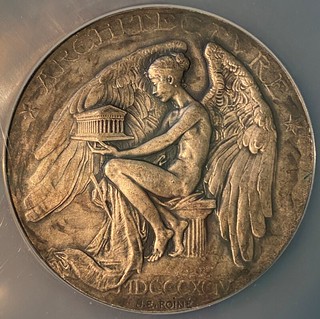
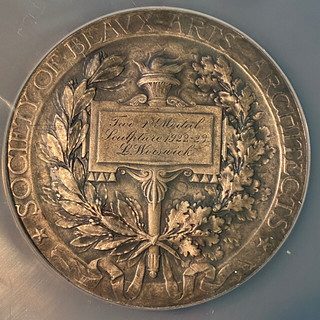
Bob also included a link to a Wikipedia article with more information on the Beaux-Arts Institute of Design. Here's an excerpt. -Editor
The Beaux-Arts Institute of Design (BAID) was an art and architectural school at 304 East 44th Street in Turtle Bay, Manhattan, in New York City. It was founded in 1916 by Lloyd Warren for the training of American architects, sculptors and mural painters consistent with the educational agenda of the French École des Beaux-Arts.
BAID grew out of the Society of Beaux-Arts Architects, a formal club of American architects who had attended the Parisian school.
From its beginning in 1894, the Society of Beaux-Arts Architects had been interested in improving architectural education in the U.S.. It took on the task of developing standard architectural "programmes" for design problems to be given as assignments in architecture schools and in independent ateliers. The intent was to raise performance standards, but the effect also was to standardize the way architecture was taught all across the United States. By 1900, most American architecture schools and many independent ateliers were participating. By 1916 the burden of providing problem statements and jurying the work from an increasing number of schools and ateliers exceeded the capacity of the Society, so it established BAID to carry on this work.
Among sculpture professionals, the foundation of BAID ensured a supply of competent decorative sculptors, and allowed the members of the National Sculpture Society to position themselves as fine artists in comparison.
The school tended to be populated by students who were either immigrants or first generation Americans. They often came from working-class backgrounds and their training was towards getting a union job in the building trades, rather than becoming a fine arts sculptor. Many of these students also attended the Art Students League of New York.
To read the complete Wikipedia article, see:
Beaux-Arts Institute of Design
(https://en.wikipedia.org/wiki/Beaux-Arts_Institute_of_Design)
RON GUTH ON COIN ORIENTATION
Ron Guth's latest blog article is about the important task of orienting coin images. Here's an excerpt - be sure to read the complete version online. -Editor

One of the more interesting puzzles facing researchers and publishers is how to orient coin images for visual purposes. In other words, how should a coin be oriented or rotated so that it appears consistent throughout a publication or across publications? For most coins, especially modern ones, visual clues on the coins themselves can be used to come up with a universally accepted orientation. On other coins, especially U.S. coins from the early 1800's, coin orientation becomes trickier.
The author ran into this problem while accumulating coin images for a visual Condition Census (the best examples of a given coin). Different sources sometimes orient coins differently such that each image must be rotated to make them consistent throughout the Census. In order to save even more work in the future, a decision should be made before images are accumulated to determine which orientation should be used.
The illustration above combines the unretouched images of the reverses of four 1796 $10 Eagles shown on the PCGS CoinFacts website at https://www.pcgs.com/coinfacts/coin/1796-10/images/8554 (lest anyone think I am picking on PCGS, they actually do a good job at being consistent with their image orientation). For this illustration, I drew a horizontal line through all of the images using the wingtip on the left side of the first coin as a reference point. The wingtips on the second and third coins are slightly lower, but both coins are oriented in nearly identical positions. The wingtip of the fourth coin is well above the line, indicating a rightward orientation.
Which of the four images would you choose as a model for orienting the reverses of 1796 $10 Eagles? Personally, I prefer the first image because it has a more balanced “look” than the other images. The position of the eagle's feet appears more natural and a horizontal line through the bottom of the U in UNITED almost touches the bottom of the second A in AMERICA. The second and third images appear to be tilted too much to the left and the fourth image is tilted too far right. You might choose a different orientation for your own reason. The key is to be consistent from image to image. Here is what the images look like when they are rotated to the same orientation:

To read the complete article, see:
Orienting Coin Images - A Case Study
(https://numismaticdetectives.com/blog/f/orienting-coin-images---a-case-study)
1794 FRANKLIN PRESS TOKEN CONSERVATION
An NGC blog article this week highlighted a few recent coins conserved by NCS. Here's one example. -Editor
A few recent NCS-conserved coins show how removing residues can greatly enhance a coin's beauty and save it from damage.
Numismatic Conservation Services™ (NCS®) uses a variety of proprietary techniques to remove harmful surface contaminants, stabilize and protect a coin's surfaces and, in many cases, improve a coin's eye appeal.
Coins made of copper alloys can develop residues in a slightly different fashion than coins of other alloys, though the chances of a residue causing permanent damage are greater. The 1794 Franklin Press token is popularly collected as a colonial coin. Residues have formed as a spotty haze on this copper alloy piece, especially apparent across the center of the reverse. The offending residues were able to be safely removed with the skillful work of NCS conservators. Upon completion of the necessary conservation work this colonial piece was able to grade with NGC.
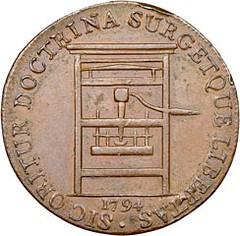
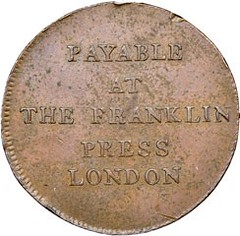
1794 Franklin Press Token before conservation
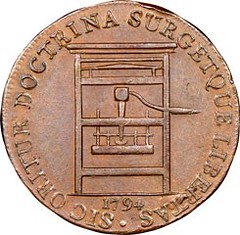
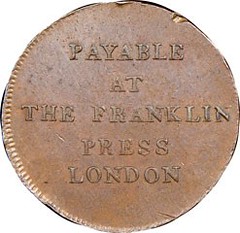
1794 Franklin Press Token after conservation
To read the complete article, see:
NCS Conservation: June Highlights
(https://www.ngccoin.com/news/article/8354/NCS-coin-conservation/)
TENINO'S 2020 WOODEN MONEY
This article has illustrations of some of the new Tenino, WA wooden scrip notes we discussed earlier. -Editor
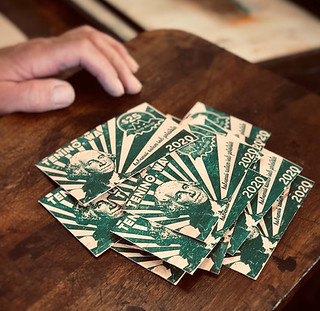 To bring back the economy, Fournier needed to act. “We were talking about grants for business, microloans, trying to team up with a bunch of different banks,” he tells The Hustle. “The big concern was, ‘How do we directly help families and individuals?'”
To bring back the economy, Fournier needed to act. “We were talking about grants for business, microloans, trying to team up with a bunch of different banks,” he tells The Hustle. “The big concern was, ‘How do we directly help families and individuals?'”
And then it hit him: “Why not start our own currency?”
The plan came together fast. Fournier decided that Tenino would set aside $10k to give out to low-income residents hurt by the pandemic. But instead of using federal dollars, he'd print the money on thin sheets of wood designed exclusively for use in Tenino. His mint? A 130-year-old newspaper printer from a local museum.
Fournier's central idea is pulled straight from Tenino's own history. During the Great Depression, the city printed sets of wooden dollars using that exact same 1890 newspaper printer. Within a year, the wooden currency had helped bring the economy back from the dead.
By reinstating the old currency now, Fournier has accidentally become part of a much bigger movement. With businesses worried about keeping the lights on and people scrambling to find spending money, communities have struggled to keep their local economies afloat.
So they've revived an old strategy: When in doubt, print your own money.
Today, these so-called “local currencies” might help small communities recover from the economic fallout of COVID-19.
Tenino's wooden dollars are different from many local currencies in that it is temporary: The money will lose its value soon after the town declares an end to its COVID-19 state of emergency.
While the Tenino project might be less ambitious than some of its counterparts, that doesn't mean its benefits won't be felt. Fournier says he's approved at least half a dozen applications for the wooden currency so far and has another dozen to review.
It's too soon to know exactly what the project will bring. But on a recent Thursday, Fournier sounded optimistic. The money has started trickling into local stores, and many businesses are posting photos of the currency to Facebook.
The project has driven enough local excitement that the Tenino Chamber of Commerce is interested in making the wooden dollars a permanent fixture of Tenino — even after the pandemic passes.
“We'll run out this program,” Fournier says, “and then we'll look into having our own city currency.”
To read the complete article, see:
Why a small town in Washington is printing its own currency during the pandemic
(https://thehustle.co/covid19-local-currency-tenino-washington/)
To read the earlier E-Sylum article, see:
TENINO REVIVES WOODEN MONEY
(https://www.coinbooks.org/v23/esylum_v23n19a35.html)
BANKNOTE MAKER DE LA RUE SAYS DEMAND STRONG
Kavan Ratnatunga forwarded this story on the demand for banknotes. Thanks. -Editor
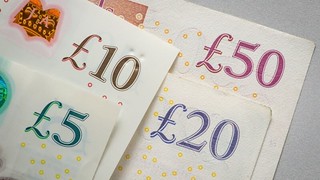 Troubled banknote maker De La Rue has said demand for its currencies remains strong, even as people switch to card payments to slow the spread of coronavirus.
Troubled banknote maker De La Rue has said demand for its currencies remains strong, even as people switch to card payments to slow the spread of coronavirus.
The company, which prints notes for the Bank of England, said it had contracts in place that would keep its currency factories working at high capacity for the rest of the year.
“In currency, De La Rue is experiencing strong demand that has continued during the Covid-19 pandemic and has been awarded contracts representing approximately 80% of its available full-year currency printing capacity,” managers said.
People around the world are opting to pay by card, especially through contactless methods when possible, to avoid handing over, and receiving, potentially contaminated cash.
Last week, PayPoint revealed that the card payments it processes had shot up by three quarters, while transactions at its cash machines fell by 40% compared with this time last year.
Apart from one site in Sri Lanka, which stopped production for eight weeks, all the company's factories have remained open throughout the pandemic.
Nor has it seen “material problems” in getting materials from suppliers.
De La Rue also revealed a new five-year contract with the Australian government to print pages for the country's new passport.
To read the complete article, see:
Demand for cash printers remains strong, says banknote maker De La Rue
(https://uk.finance.yahoo.com/news/demand-cash-printers-remains-strong-091947426.html)
FORREST FENN REPORTS TREASURE FOUND
Richard Miranda, Arthur Shippee and Dick Hanscom passed along this new story about that Forest Fenn treasure. -Editor
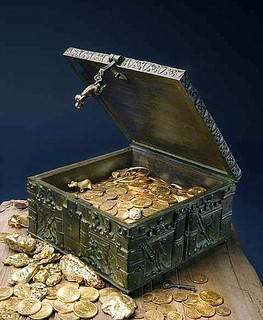 Famed art and antiquities collector Forrest Fenn, who hid $1 million in treasure in the Rocky Mountain wilderness a decade ago, said Sunday that the chest of goods has been found.
Famed art and antiquities collector Forrest Fenn, who hid $1 million in treasure in the Rocky Mountain wilderness a decade ago, said Sunday that the chest of goods has been found.
Fenn, 89, told the Santa Fe New Mexican that a treasure hunter located the chest a few days ago.
“The guy who found it does not want his name mentioned. He's from back East,” Fenn said, adding that it was confirmed from a photograph the man sent him. Fenn did not reveal exactly where it had been hidden.
Fenn posted clues to the treasure's whereabouts online and in a 24-line poem that was published in his 2010 autobiography "The Thrill of the Chase."
Hundreds of thousands have hunted in vain across remote corners of the U.S. West for the bronze chest believed to be filled with gold coins, jewelry and other valuable items. Many quit their jobs to dedicate themselves to the search and others depleted their life savings. At least four people died searching for it.
Fenn, who lives in Santa Fe, said he hid his treasure as a way to tempt people to get into the wilderness and give them a chance to launch an old-fashioned adventure and expedition for riches.
For more than a decade, he packed and repacked his treasure chest, sprinkling in gold dust and adding hundreds of rare gold coins and gold nuggets. Pre-Columbian animal figures went in, along with prehistoric “mirrors” of hammered gold, ancient Chinese faces carved from jade and antique jewelry with rubies and emeralds.
Fenn told The New Mexican in 2017 that the chest weighs 20 pounds and its contents weigh another 22 pounds. He said he delivered the chest to its hiding place by himself over two separate trips.
Asked how he felt now that the treasure has been found, Fenn said: “I don't know, I feel halfway kind of glad, halfway kind of sad because the chase is over.”
I was surprised to see mainstream publications including the New York Times carrying this story without seeming to investigate its claim. All along people have taken Fenn at his word that the treasure exists in the first place, even after treasure hunters have died searching for it. And now that he claims it's been found we have no evidence of that, either. I'm not from Missouri, but please Show Me. -Editor
To read the complete article, see:
Forrest Fenn's $1 million treasure hidden in Rocky Mountains found
(https://www.lcsun-news.com/story/news/local/2020/06/07/forrest-fenn-treasure-hidden-rocky-mountains-found/3171057001/)
To read other media articles, see:
Someone Found a Buried Treasure Hidden in the Rocky Mountains
(https://www.nytimes.com/2020/06/08/us/treasure-chest-rocky-mountains.html)
Forrest Fenn: Collector says his $1m Rocky Mountain treasure hunt has been won
(https://www.bbc.com/news/world-us-canada-52966449)
However, while the Daily Mail tabloid isn't a paragon of fact-checking accuracy, it did publish the first article I'd seen questioning the existence of Fenn's treasure. Thanks to Dick Hanscom for passing this along. -Editor
But some people have expressed skepticism over Fenn's announcement given the lack of details about who found the treasure, when and where.
Among the critics is Linda Bilyeu, whose ex-husband, Randy Bilyeu, disappeared during his search in the New Mexico wilderness in January 2016 and was found dead six months later.
'I believe [Fenn] never hid the treasure,' Linda Bilyeu told Westworld on Monday morning.
'He needed attention and this is how he got it. Fenn needed more attention, which is why he said the treasure has been found with "no proof."
'Randy lost his life searching for "nothing."'
To read the complete article, see:
Is the $1million Fenn Forest treasure a HOAX? Ex-wife of one of five men who died searching for the chest claims it was never buried and news that it has been discovered is a publicity stunt
(https://www.dailymail.co.uk/news/article-8399549/Ex-wife-man-died-searching-1m-Forrest-Fenn-treasure-chest-says-HOAX.html)
The New York Post has one of the best articles I've seen so far. Interesting reading, at least. -Editor
Fenn, who has readily admitted that he sold forged art at his gallery in the past, has said little else, and has not made the image of the “found” treasure chest public. He did not return phone or email messages from The Post.
So far, his announcement, which effectively ended the treasure hunt, has resulted in a great deal of bitterness and even a lawsuit.
“This is all really heartbreaking. When I heard the news last week I just freaked out,” said Barbara Andersen, a Chicago lawyer who claims she spent tens of thousands of dollars on 20 trips to New Mexico and had communicated her findings in dozens of emails to Fenn over the years.
She alleges her computer was hacked and her “solve stolen” by a man she doesn't know who had been threatening her with texts over the last few months. She filed suit against Fenn and the “unknown defendant” in Chicago federal court on Monday, two days after Fenn's announcement.
The unidentified hunter “found the precise location of the Forrest Fenn treasure not because he solved the puzzle, but because he intentionally hacked Andersen's computer and e-mails … and stalked Andersen physically at the location site,” the lawsuit charges.
Andersen, 47, who refuses to give up the search, spoke to The Post from a campsite in New Mexico. She said that she was first drawn to the state after Fenn offered a clue in a blog post where he showed a picture of a beat-up hat with a large hole in it.
“If you look closely the hole is in the shape of the state of New Mexico,” said Andersen, who has made the trips to search for the treasure accompanied by her dog, Cupcake.
Thousands of others are also furious at Fenn, a transplanted Texan and former Air Force pilot who flew in hundreds of combat missions during the Vietnam war, and has long run the Old Santa Fe Trading Company where he has a vast collection of arrowheads and native American art.
“Why aren't you showing us the picture?” demanded Terry Kasberg, a Florida realtor who has spent the last four years searching for the treasure, and belongs to a Facebook group of more than 4,000 ardent treasure seekers — “Treasures Galore” — devoted to sharing information about the search for Fenn's cache. He said he has read Fenn's book 23 times searching for clues.
“Everyone is really concerned because there is a real lack of transparency,” he told The Post. “It has left everyone in a depressed state of mind.”
To read the complete article, see:
Inside one woman's dogged hunt to find Forrest Fenn's buried treasure
(https://nypost.com/2020/06/13/inside-one-womans-dogged-hunt-to-find-forrest-fenns-buried-treasure/)
To read the earlier E-Sylum articles, see:
TREASURE SEEKERS SEARCH FOR AUTHOR'S HIDDEN CHEST
(https://www.coinbooks.org/esylum_v18n29a41.html)
TREASURE SEARCH TURNS INTO HUNT FOR SEARCHER
(https://www.coinbooks.org/esylum_v19n05a34.html)
AUTHOR'S TREASURE SEARCH BRINGS ANOTHER DEATH
(https://www.coinbooks.org/v20/esylum_v20n26a35.html)
NEW YORK TIMES PROFILES ARTIST JOHNNY SWING
Earlier E-Sylum articles discussed the work of artist Johnny Swing, who creates furniture artworks incorporating coins. The New York Times published a profile on him on May 31, 2020. Here's an excerpt. Found via the News & Notes newsletter from Society of Paper Money Collectors (Volume V, Number 51, June 9, 2020). -Editor
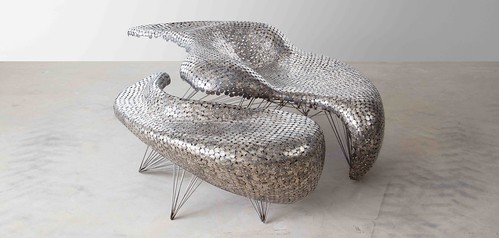
These days Mr. Swing, 59, works a short drive down the mountain from his home in a 5,500-square-foot studio he designed himself, with high ceilings, soaring windows and dedicated spaces for carving, modeling and welding. A small team assists him in creating his sculptures of twisted steel cable and repurposed metal objects, his architectonic lighting fixtures and — the thing everyone knows Johnny Swing for — his sofas, chairs and benches made from shimmering coins.
Typically, he makes only a handful of coin pieces a year, as each design requires thousands of nickels, quarters, half-dollars or dollar coins, all meticulously joined with upward of 60,000 welds, depending on the size of the piece and the coin used. The metalworking alone can stretch to 300 hours or more, sometimes spread out over months.
Intense and playful, Mr. Swing has an expansive, restless energy. “I'm too old to have been diagnosed with A.D.D. or whatever, but I'm kind of manic and I love to bounce between two and three different things going at once,” he said. He's been known to take breaks by bombing around the adjacent field on his snowmobile at 100 miles per hour.
Lately, Mr. Swing has been focused on his most challenging body of coin furniture yet. It's a group of seven biomorphic designs that fit together, puzzle-like, in a configuration that suggests an undulating landscape or, more whimsically, a fried egg. There's a circular stool or table that forms the “yolk,” while sculptural seats of varying shapes and dimensions compose the “white.”
Mr. Swing also likened the swirling forms to sea creatures that, nested together, call to mind a whale.
Planned as the centerpiece of his debut solo show with the Tribeca design gallery R & Company —his first in New York City in eight years — the new designs are being produced in two versions, one made with nickels and one with dollar coins. (Because of the coronavirus outbreak, the show was moved from May tentatively to the fall.) The works will be sold as complete sets and separately, with individual pieces starting around $20,000.
“Johnny is a leader in the American studio furniture movement, a renegade D.I.Y.-type artist and craftsman who's taken an everyday commodity and used his technical skills as a welder to turn it into a luxury material,” said Zesty Meyers, R & Company's co-founder. “People are hungry for things that are uniquely handmade. It's the defining taste for billionaires today.”
Mr. Swing's choice of coins as a medium invites a variety of interpretations. Is the work a wry critique of capitalism? A wink at the investment value of art and luxury furnishings? A commentary on our obsession with money? Studies that have shown that simply touching currency can elevate people's emotional states, and a Swing sofa or chair invites sitters to immerse themselves in cold, hard — though surprisingly comfortable — cash.
But Swing is no ideologue. He views coins as an intriguingly malleable, multivalent material and as “beautiful little sculptures in their own right.” Having always repurposed found and castoff materials, he likes that coins possess past lives, trading hands countless times and traveling unknowable distances.
To read the complete article, see:
Newly Minted Work by a Change Artist
(https://www.nytimes.com/2020/05/31/arts/johnny-swing-coin-artist.html)
To read earlier E-Sylum articles, see:
JOHNNY SWING'S COIN FURNITURE
(https://www.coinbooks.org/esylum_v13n13a24.html)
ARTIST JOHNNY SWING'S PENNY CHAIR
(https://www.coinbooks.org/esylum_v19n46a47.html)
VERMONT ARTIST CREATES FURNITURE USING COINS
(https://www.coinbooks.org/esylum_v14n17a25.html)
LOOSE CHANGE: JUNE 14, 2020
Here are some additional items in the media this week that may be of interest. -Editor
A Muled 1840-(O) Half Dollar
Steve Roach highlighted a VERY interesting U.S. coin sold in April by Heritage in a June 8, 2020 Coin World article. Congratulations to the buyer. -Editor
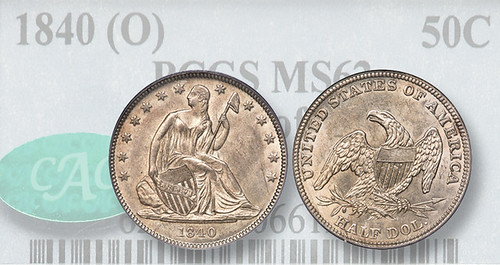
“At one time thought to be a Philadelphia Mint issue, the 1840-(O) is essentially a muling of two half dollar series — pairing a Seated half obverse with an 1839 Capped Bust half reverse (type of 1838 with Medium Letters and a larger eagle).”
The 1839-O Capped Bust half dollars featured an obverse Mint mark, so reverse dies for half dollars that year show no Mint mark. Seated Liberty half dollars had the Mint mark on the reverse.
To read the complete article, see:
Market Analysis: Where's the New Orleans ‘O' Mint mark on this half dollar?
(https://www.coinworld.com/news/us-coins/market-analysis-where-s-the-new-orleans-o-mint-mark-on-this-half-dollar)
Bolen's Springfield Pioneer Baseball Club Medal
Over on the Coin Talk discussion board, John Milton published a nicely researched and illustrated article on Bolen's Springfield, MA Pioneer Baseball Club Medal -Editor
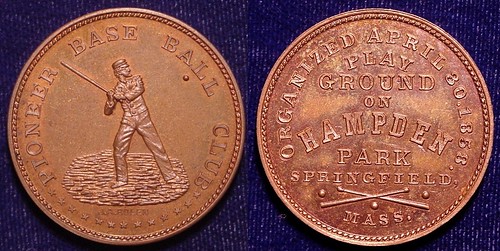
As the Major League Baseball owners and players debate whether or not there will be a season, I thought it would be appropriate to look and one of baseball's earliest collectables, the Springfield, Massachusetts baseball medal. This piece, which was issued in 1861 at the dawn of the Civil War, provides us with a glimpse of mid 19th century American life. In those days, baseball was not just a game that children and adult professional baseball players played that a much larger number of fans only watched. It was a sport that provided the nucleus for social clubs that gathered for recreational activities the year round. In fact some clubs spent so much time having parties, dances and dinners that they almost forgot about the games on the field!
To read the complete article, see:
The Springfield, Massachusetts Pioneer Baseball Club Medal
(https://www.cointalk.com/threads/the-springfield-massachusetts-pioneer-baseball-club-medal.361425/)
2021-dated Morgan and Peace Silver Dollars
The U.S. Congress has been distracted by current events, but don't forget there are coinage bills working their way through the system, too. CoinWeek published another article about the legislation for 2021-dated Morgan and Peace silver dollars. -Editor
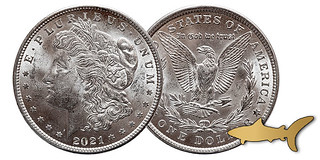 Last year the 1921 Silver Dollar Commemorative Coin Act, which proposed issuing 2021-dated Morgan silver dollars and Peace dollars, was introduced. Though the proposed program remains popular with collectors, the bill never gained much support in Congress. Just before the year ended, the Congress passed the Law Enforcement Commemorative Coin Act and earlier in the year it had passed the Christa McAuliffe Commemorative Coin Act. Since only two commemorative programs can be issued per year, this appeared to mean there would be no 2021 Morgan and Peace dollars.
Last year the 1921 Silver Dollar Commemorative Coin Act, which proposed issuing 2021-dated Morgan silver dollars and Peace dollars, was introduced. Though the proposed program remains popular with collectors, the bill never gained much support in Congress. Just before the year ended, the Congress passed the Law Enforcement Commemorative Coin Act and earlier in the year it had passed the Christa McAuliffe Commemorative Coin Act. Since only two commemorative programs can be issued per year, this appeared to mean there would be no 2021 Morgan and Peace dollars.
But on March 11 a new approach to doing this was proposed by Rep. Andy Barr (R-KY06), the 1921 Silver Dollar Coin Anniversary Act (H.R. 6192), which if enacted would result in the issuance of 2021-dated Morgan and Peace silver dollars to mark the centennial of the transition in 1921 from the Morgan dollar to the Peace dollar series. Those coins would not be commemoratives but would be legal tender silver coins issued beginning January 1, 2021, that contain at least 90% silver.
If you as a collector support the issuance of 2021 Morgan and Peace dollars, be sure to contact your congressional representative and ask them to support the bill.
To read the complete CoinWeek articles, see:
New Plan for 2021-Dated Morgan and Peace Silver Dollars
(https://coinweek.com/us-coins/new-plan-for-2021-dated-morgan-and-peace-silver-dollars/)
A Coin Analyst Exclusive: Morgan and Peace Silver Dollars Proposed as Ongoing Program
(https://coinweek.com/modern-coins/a-coin-analyst-exclusive-morgan-and-peace-silver-dollars-proposed-as-ongoing-program/)
To read the earlier E-Sylum article, see:
1921 SILVER COIN ANNIVERSARY ACT SUPPORT SOUGHT
(https://www.coinbooks.org/v23/esylum_v23n12a17.html)
How the Fed Makes Money
Here's a good explainer article on how the U.S. Federal Reserve literally makes money. -Editor
It is common to hear people say the Fed prints money.
That's not technically correct. The Bureau of Engraving and Printing, an agency of the U.S. Treasury, does the printing. The Fed, for its part, purchases cash from the bureau at cost and then puts it in circulation.
Although you may have heard some economists talk about the Fed figuratively dropping cash from helicopters, its method of distribution isn't quite as colorful.
To read the complete article, see:
How the Federal Reserve literally makes money
(https://theconversation.com/how-the-federal-reserve-literally-makes-money-140305)
FEATURED WEB SITE: GELDSCHEINE-ONLINE
This week's Featured Web Site is Geldscheine-Online.com, the German paper money online magazine. Suggested by Ray Williams.Are you interested in all kinds of banknotes? Are you looking for interesting literature that fits your collection? Or do you just want to familiarize yourself a little with the history of paper money? Then you are exactly right here! Browse through our interesting articles and banknotes and find out about current auctions and stock exchanges.

www.geldscheine-online.com/

